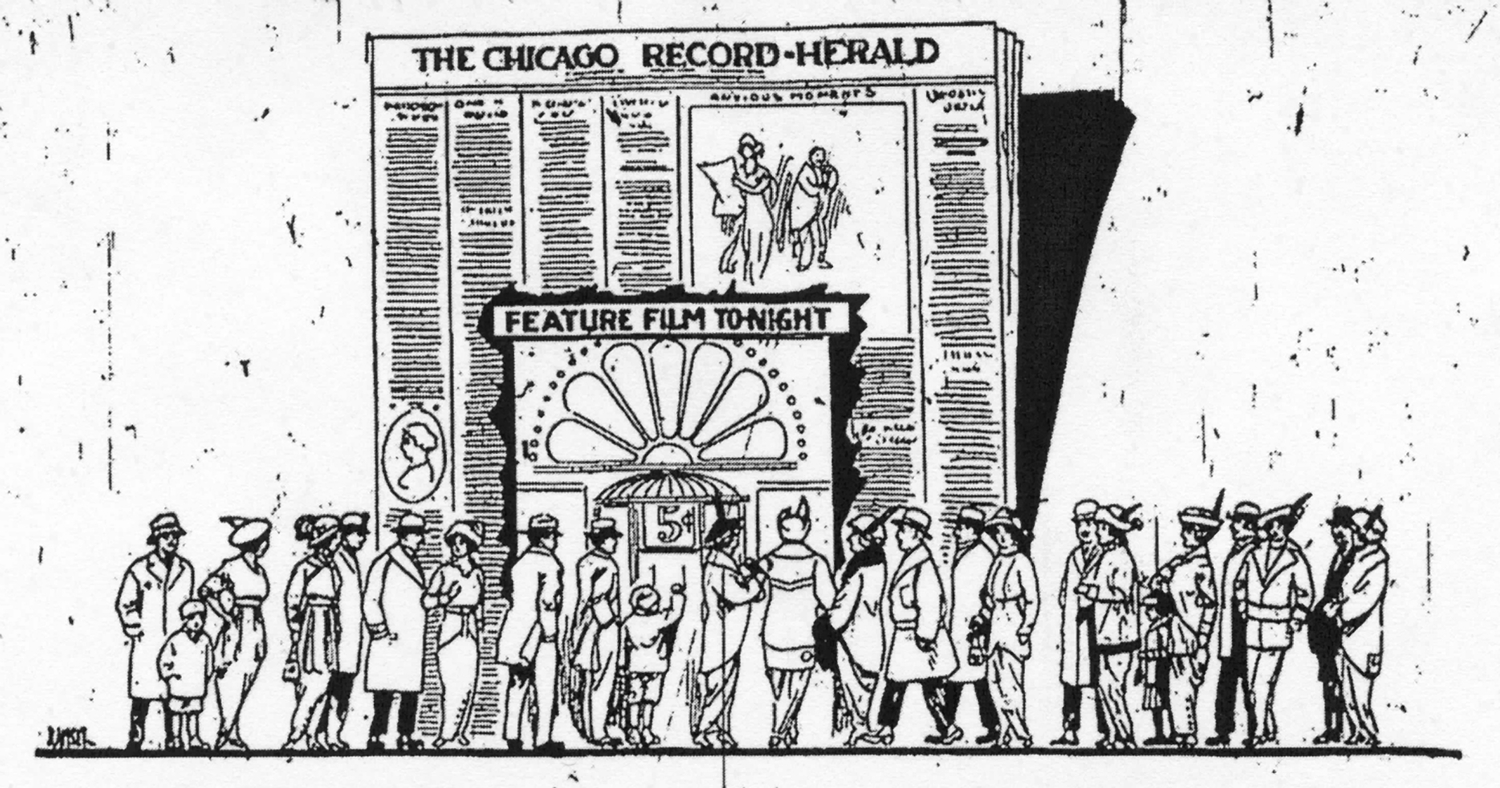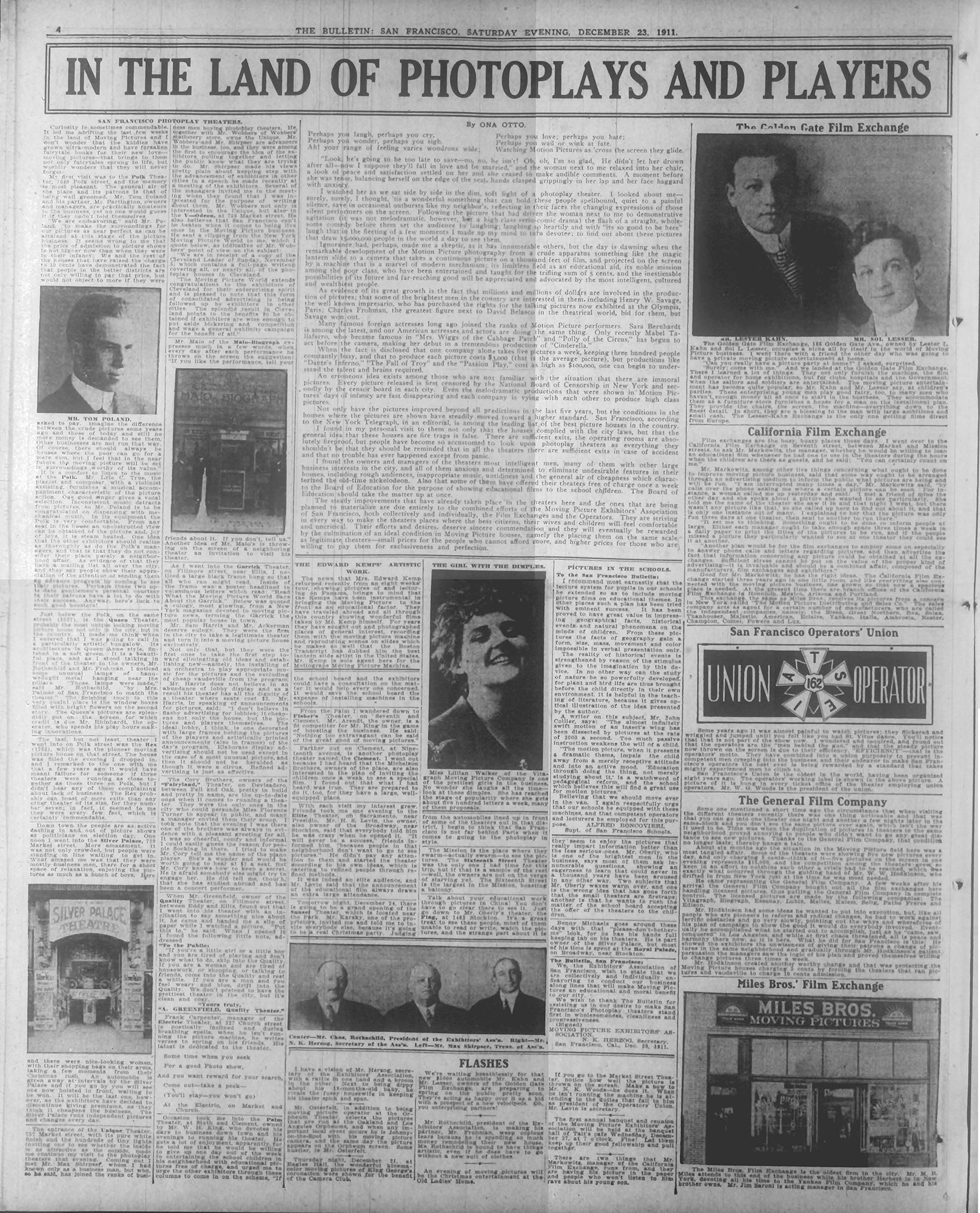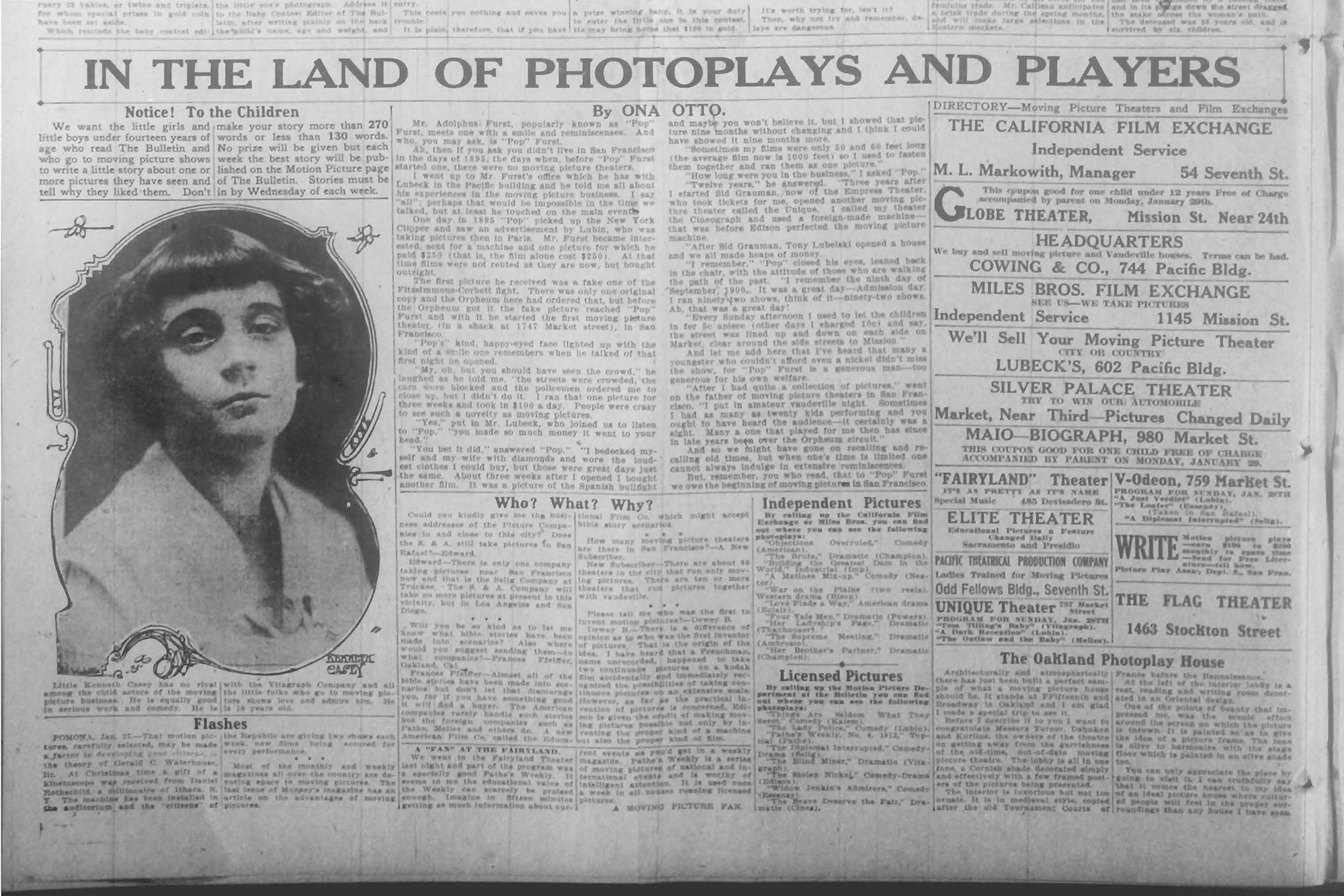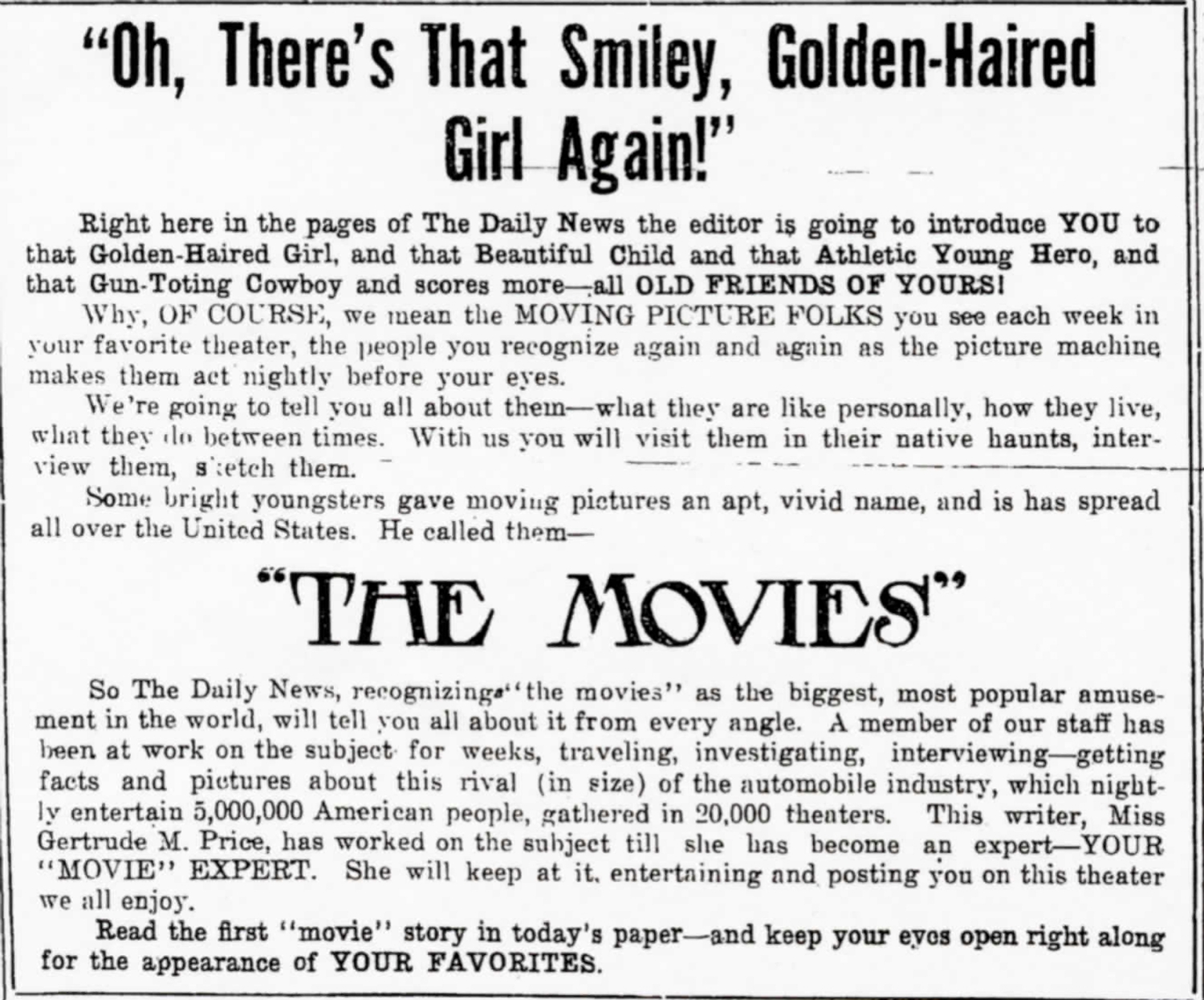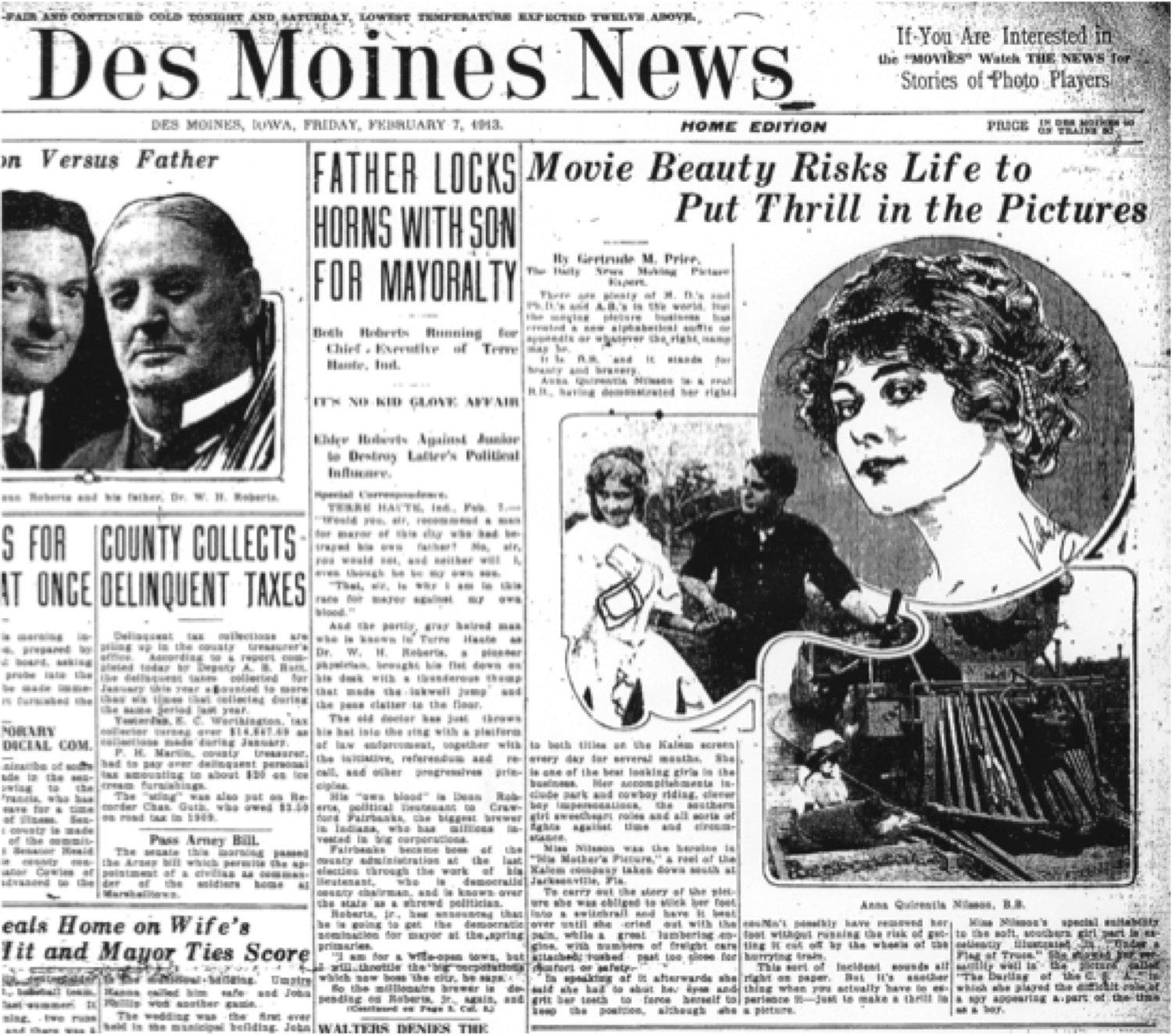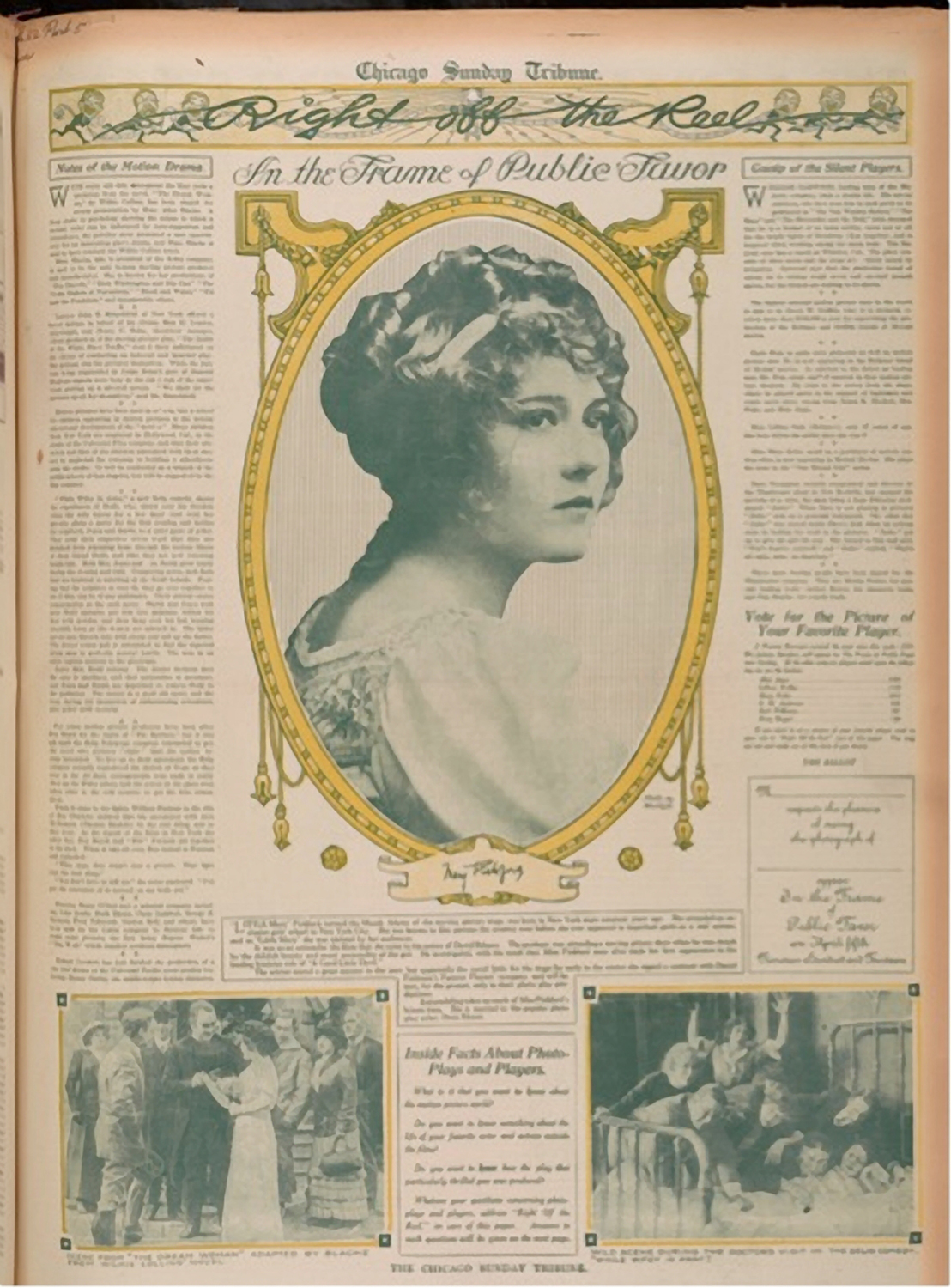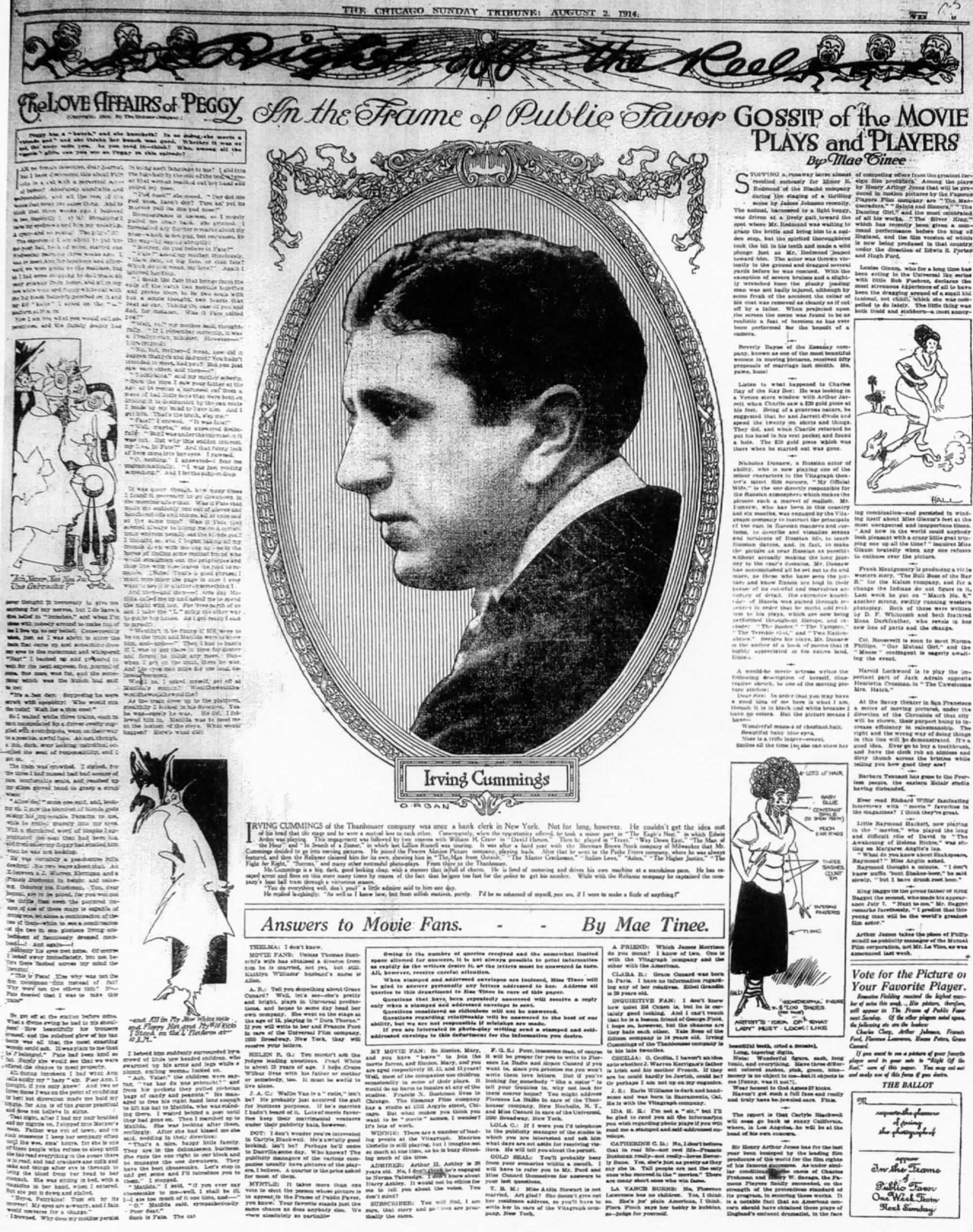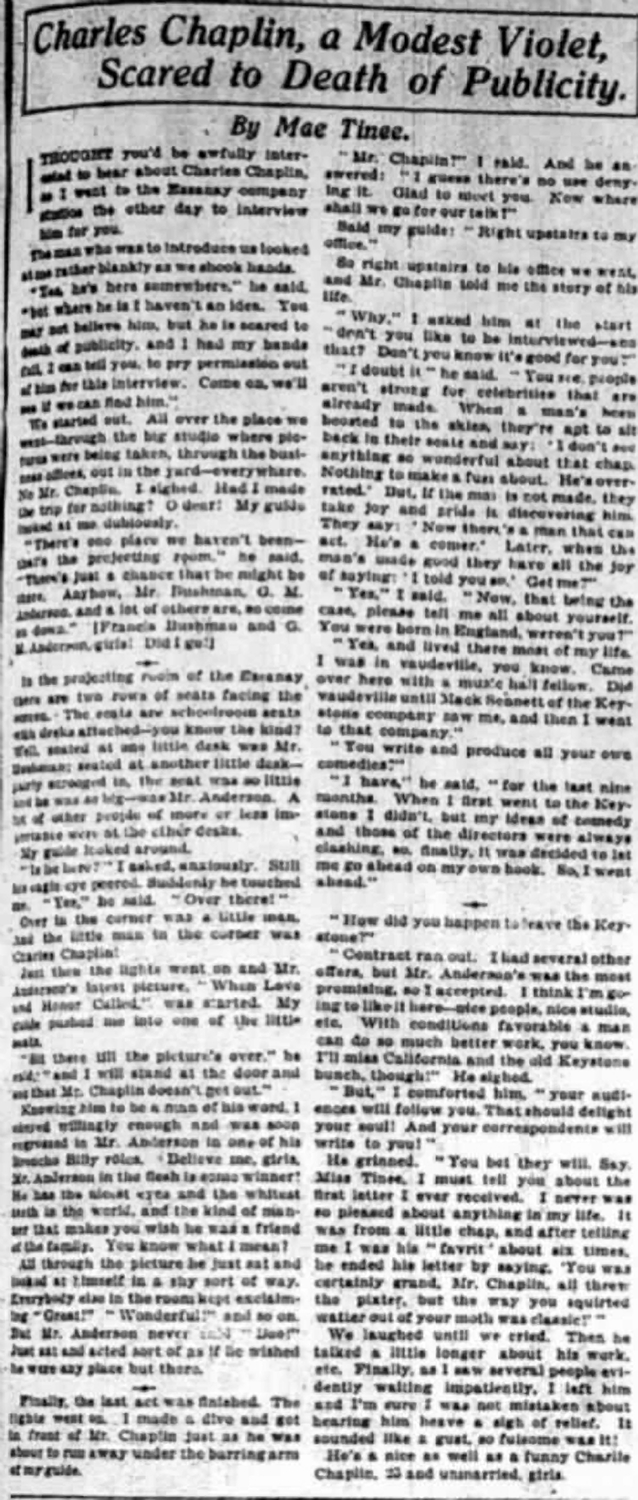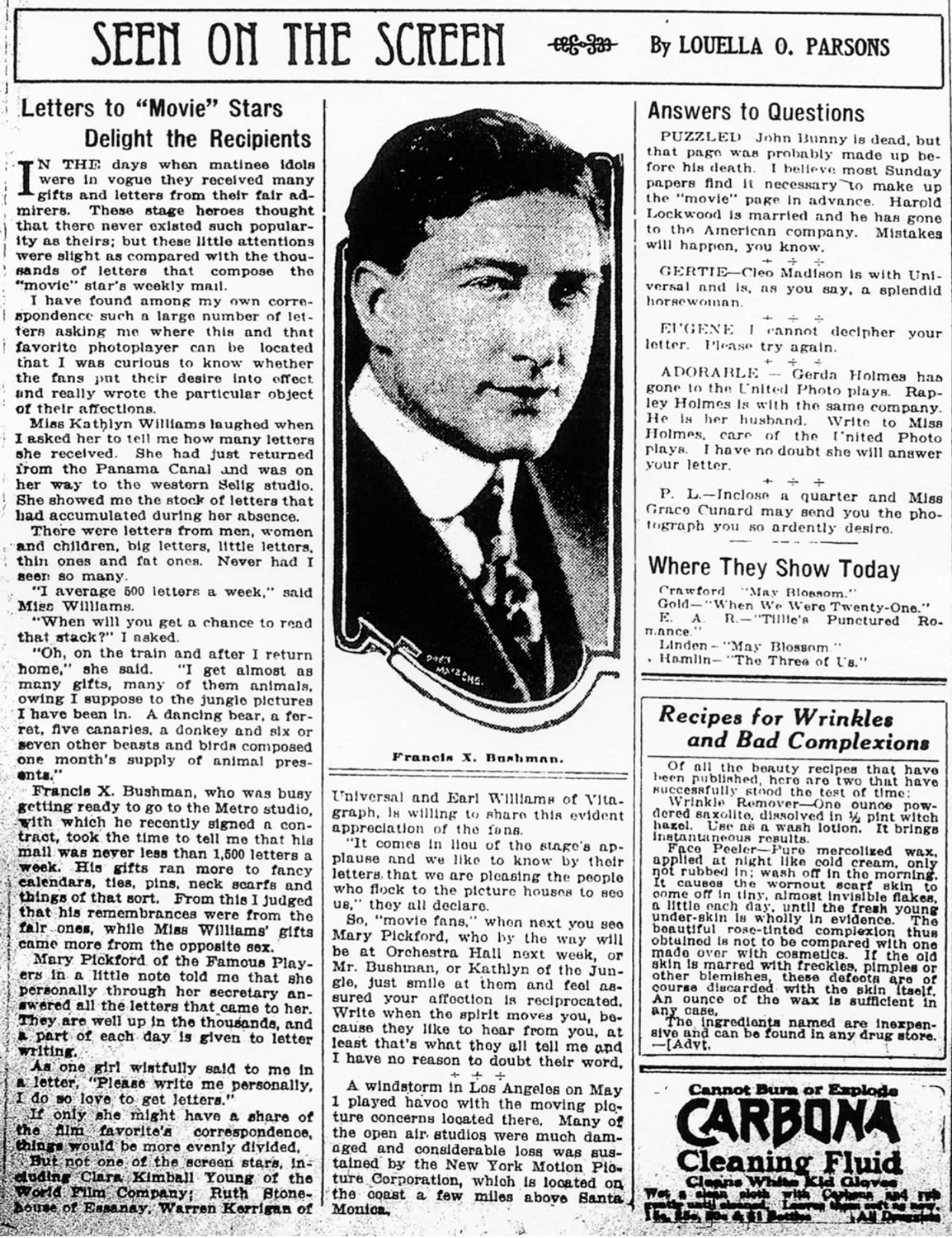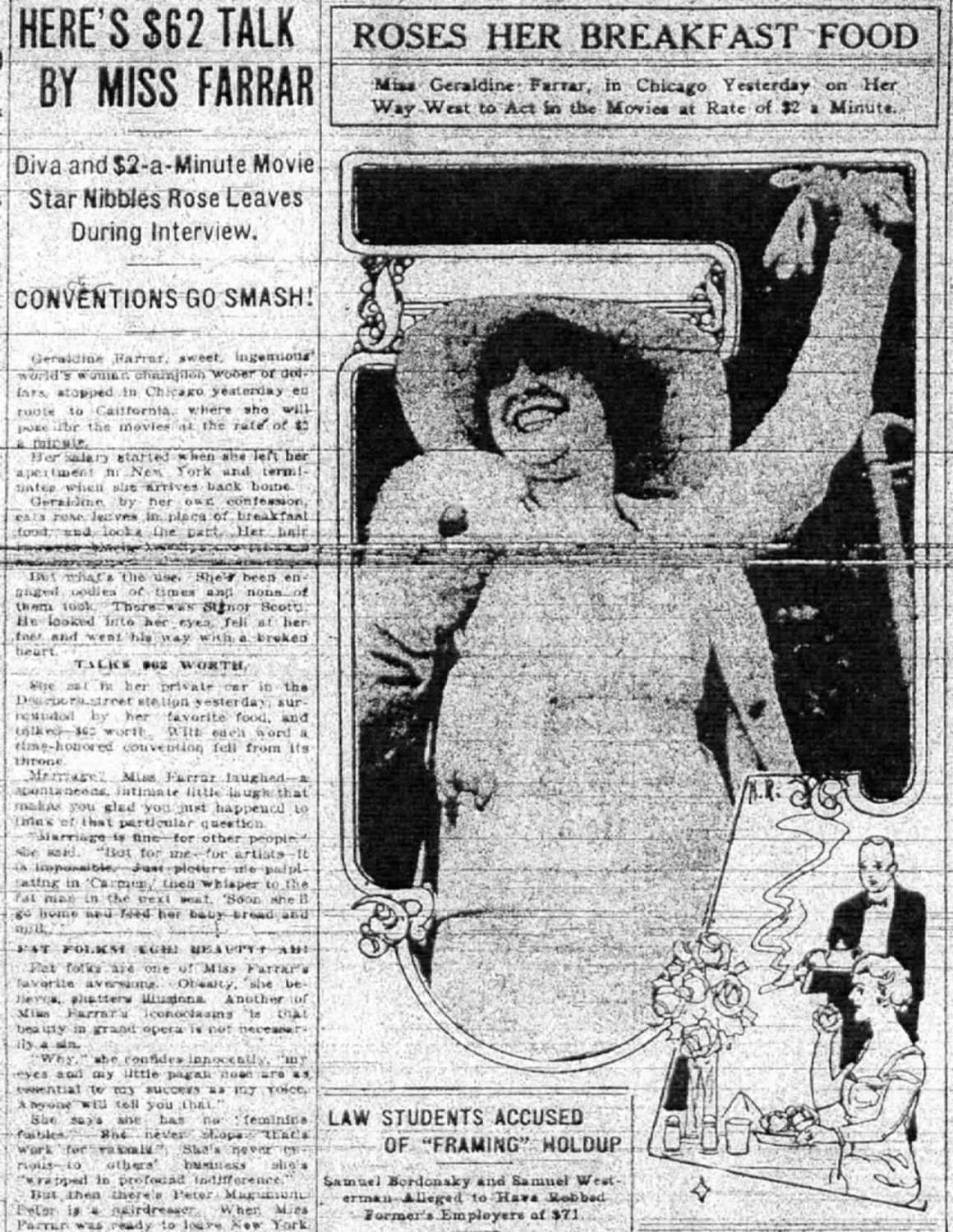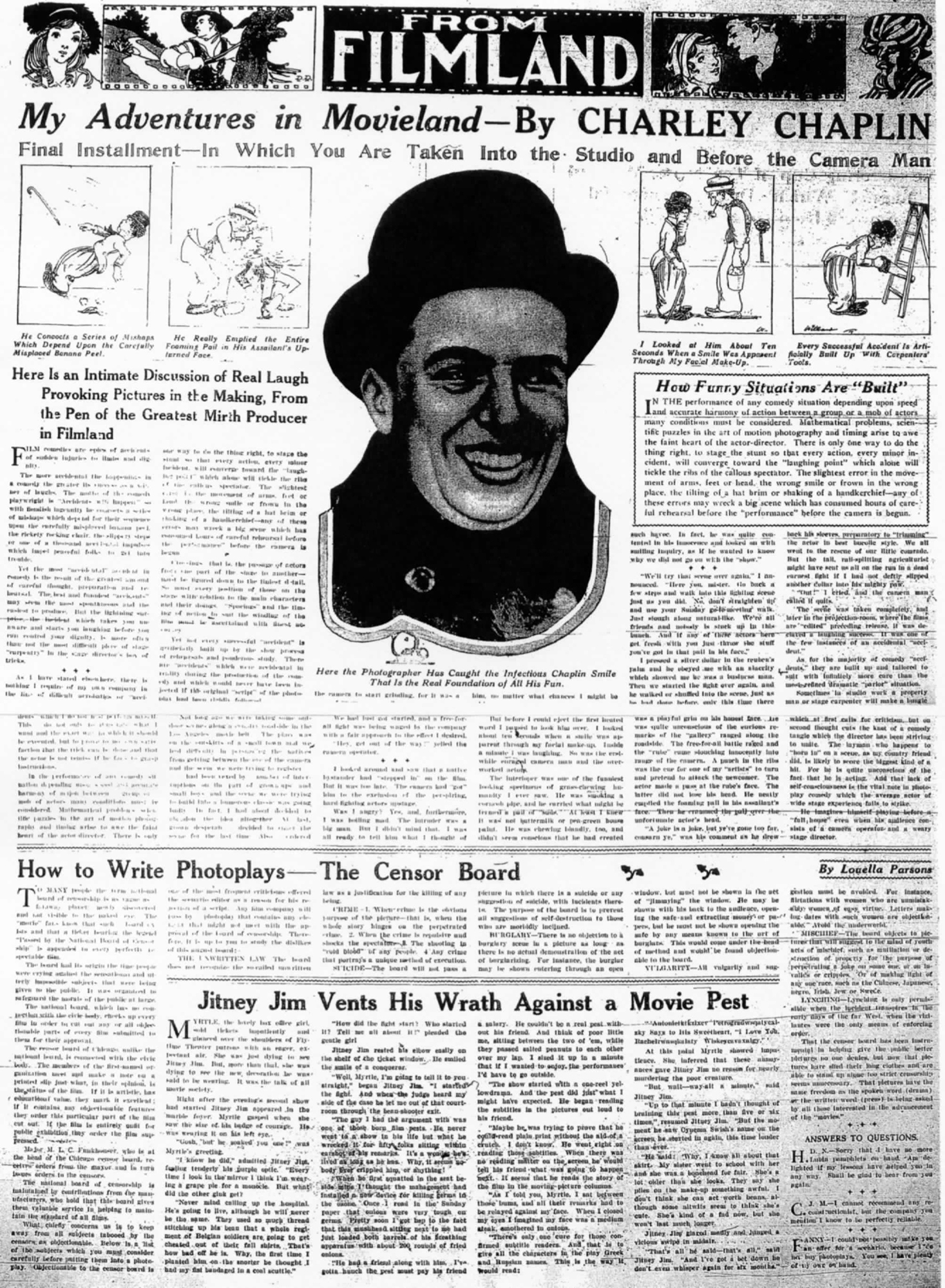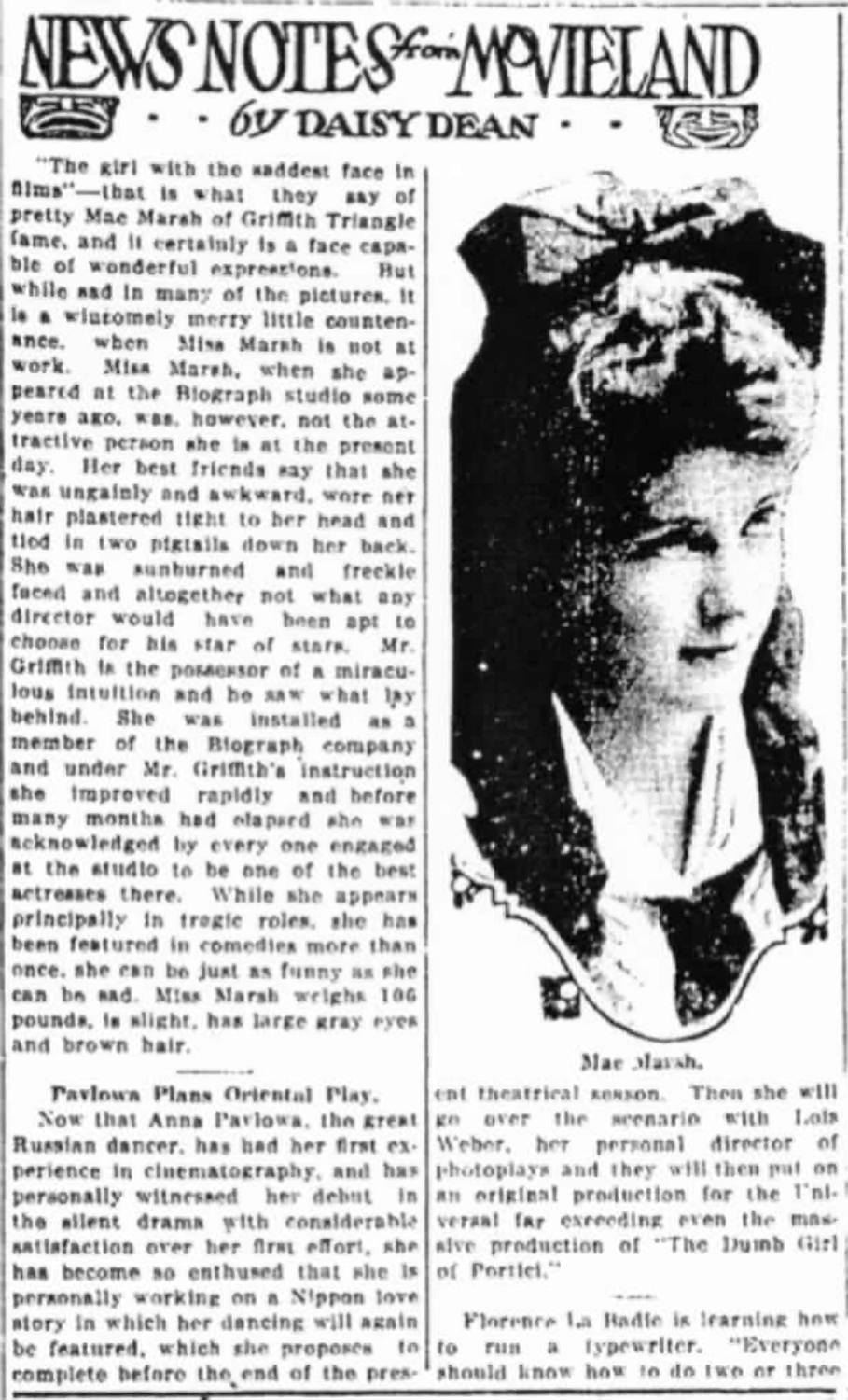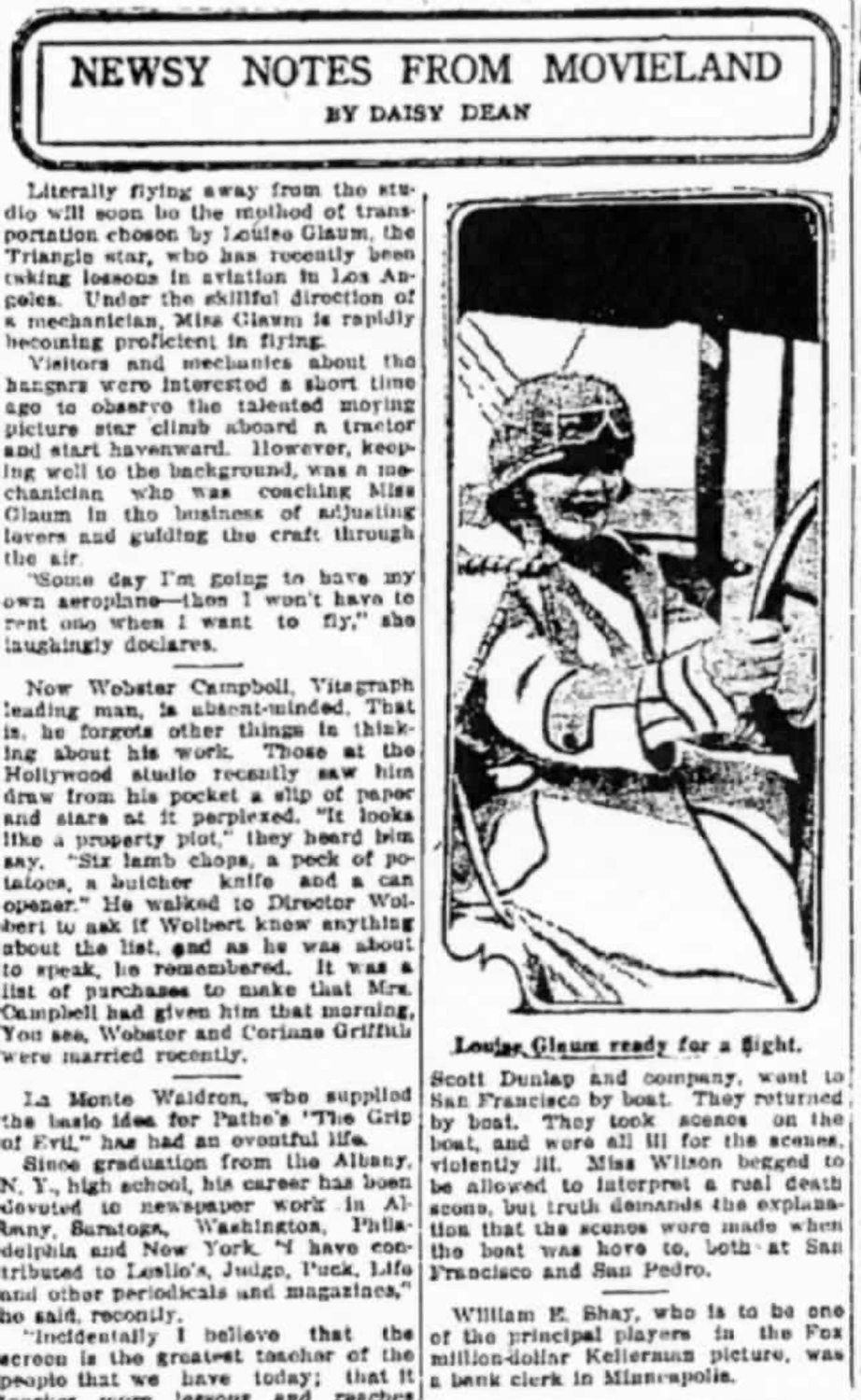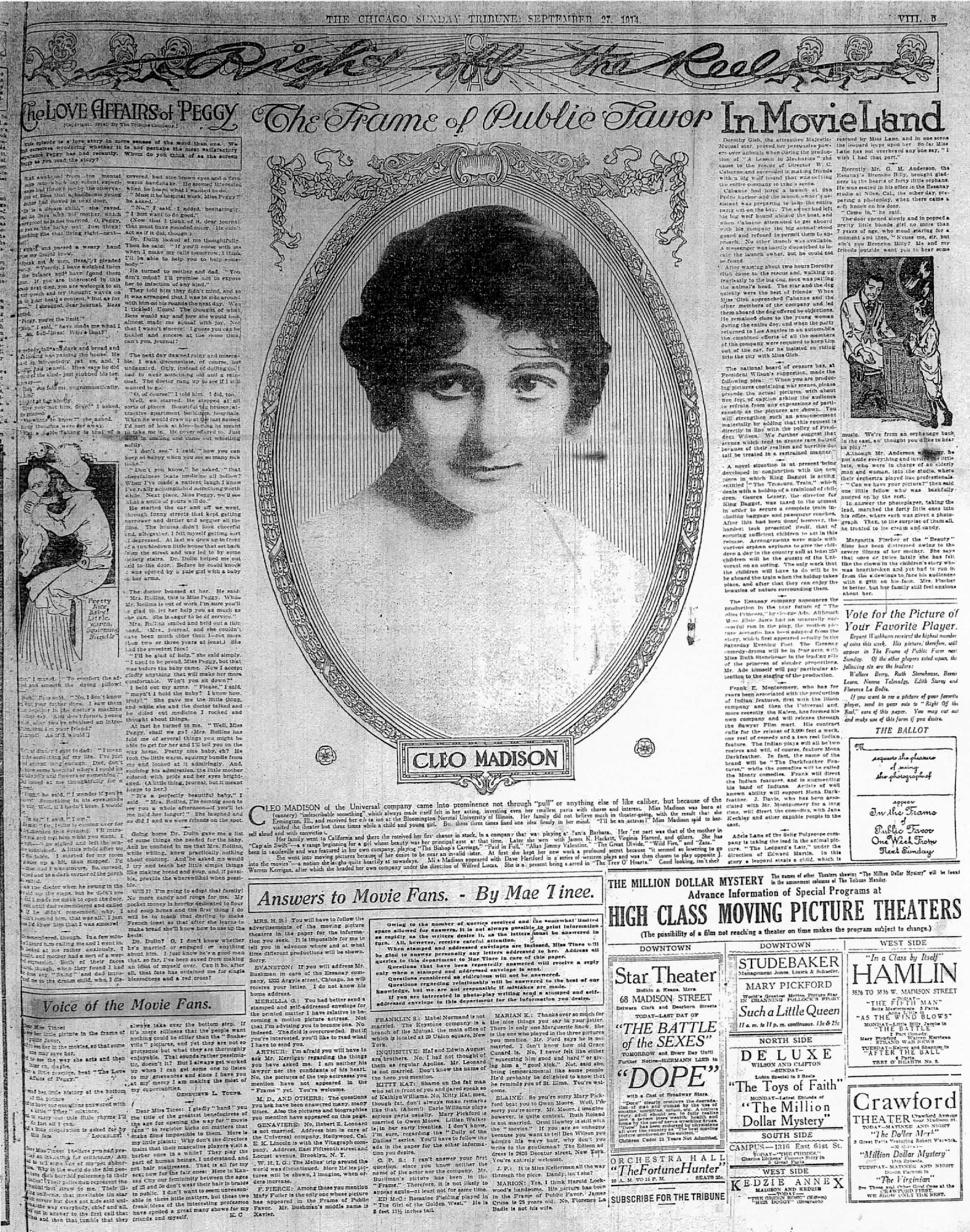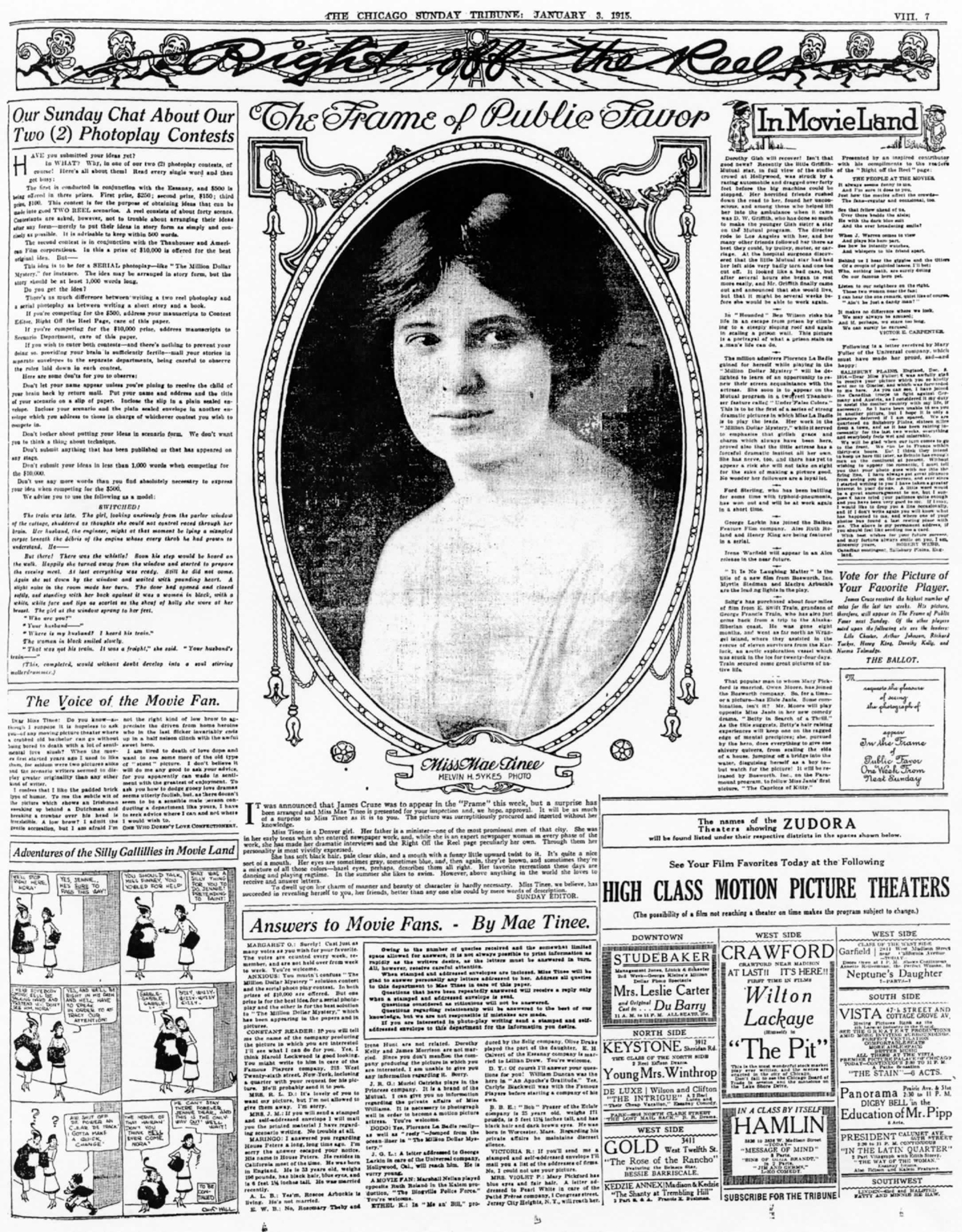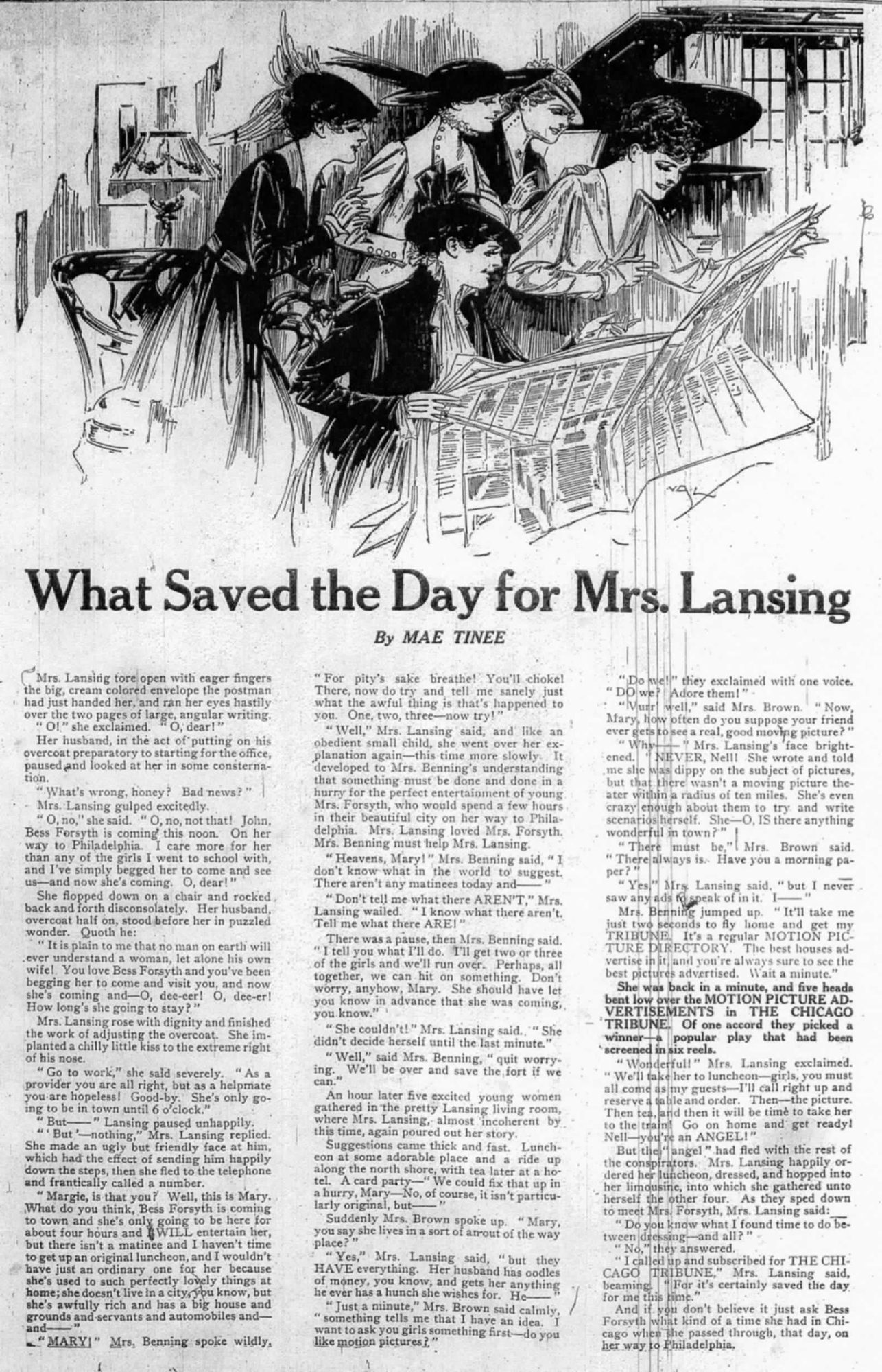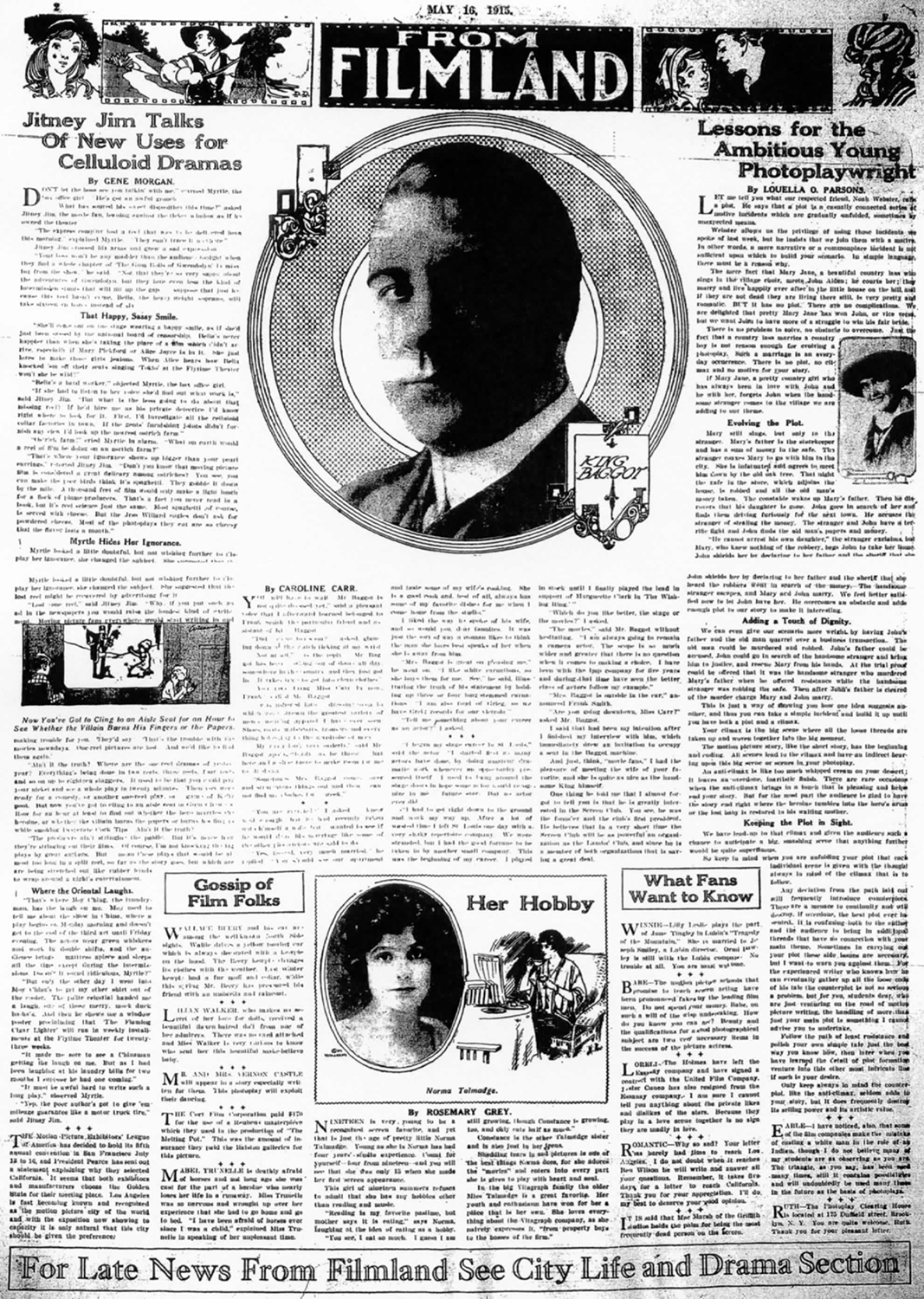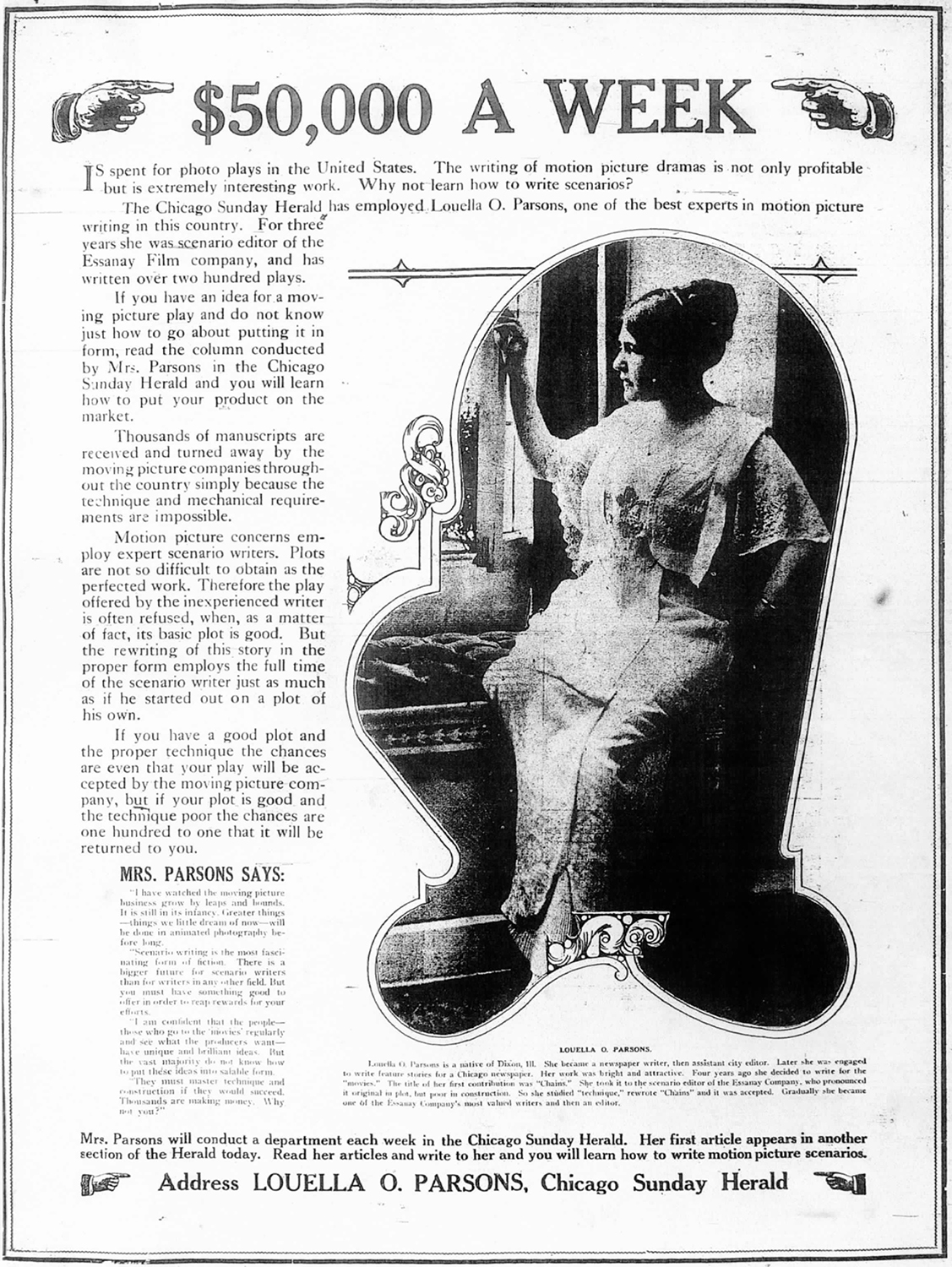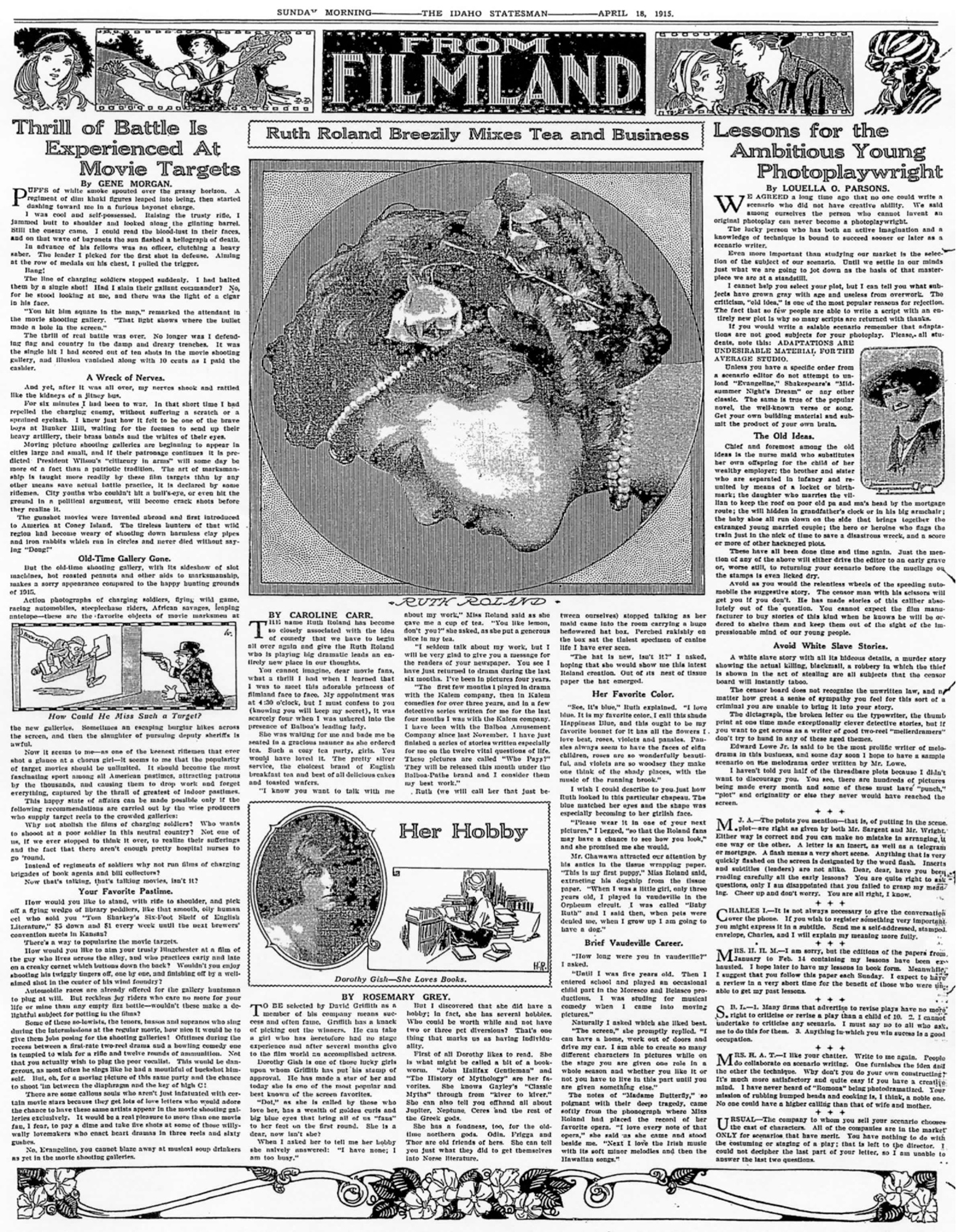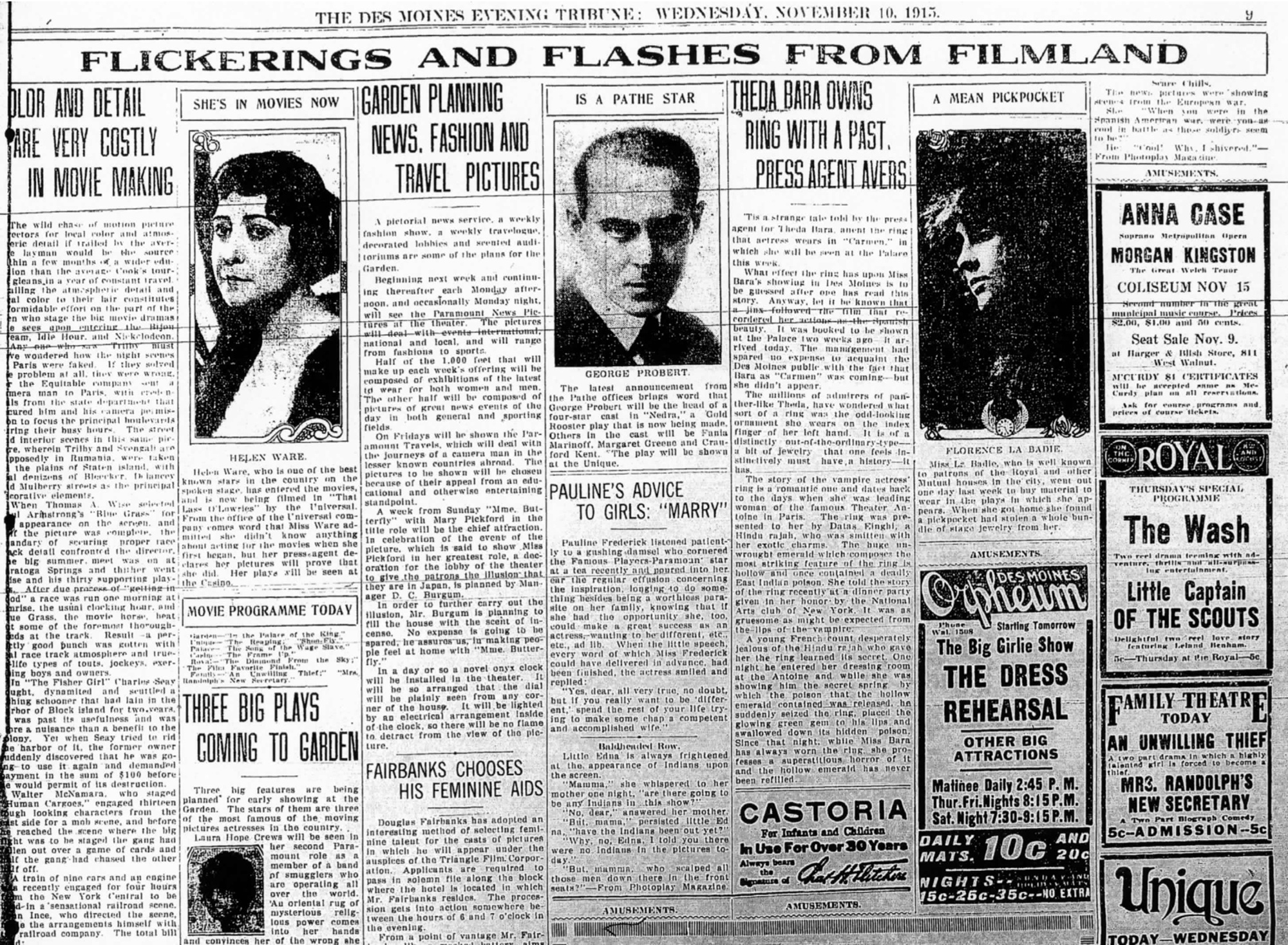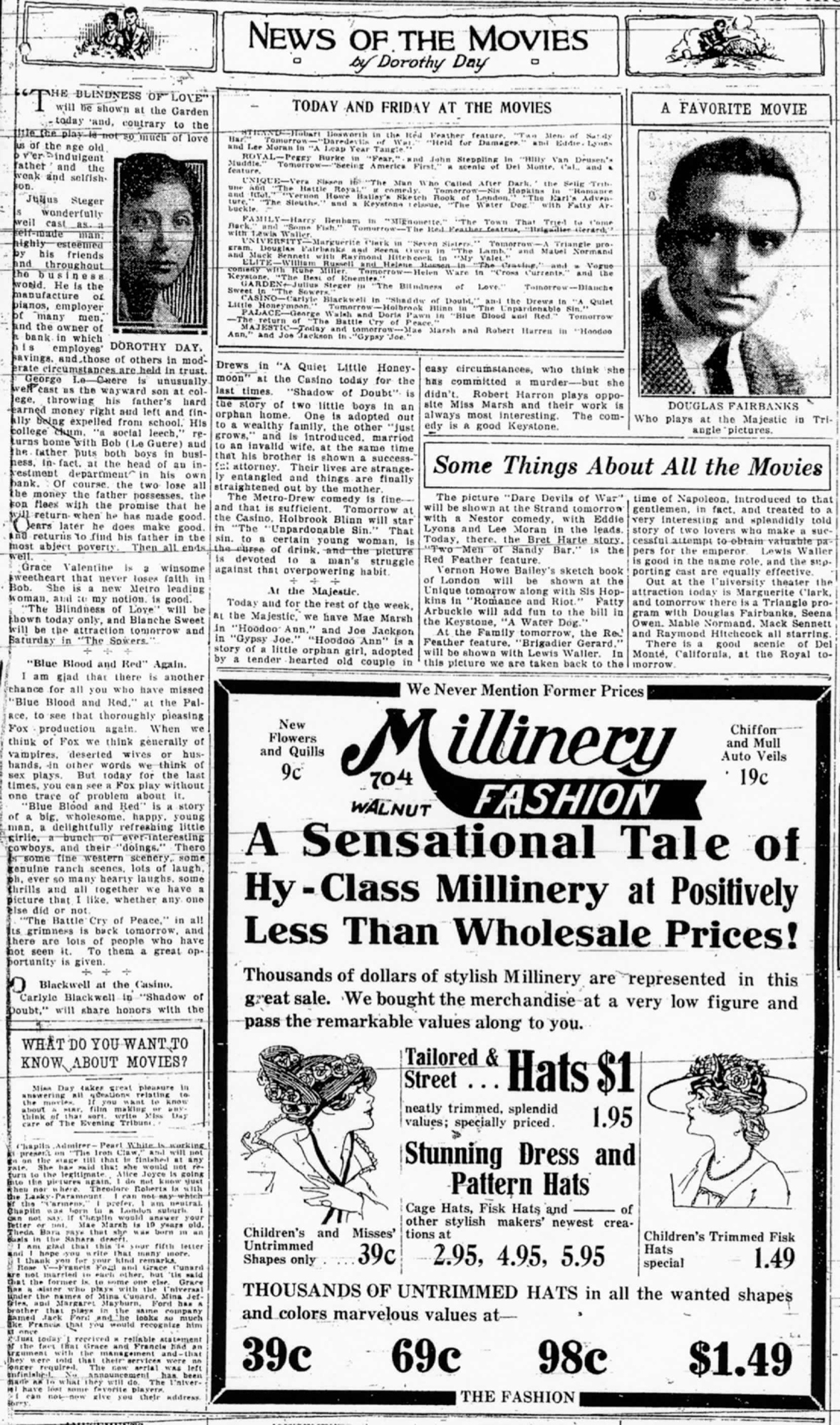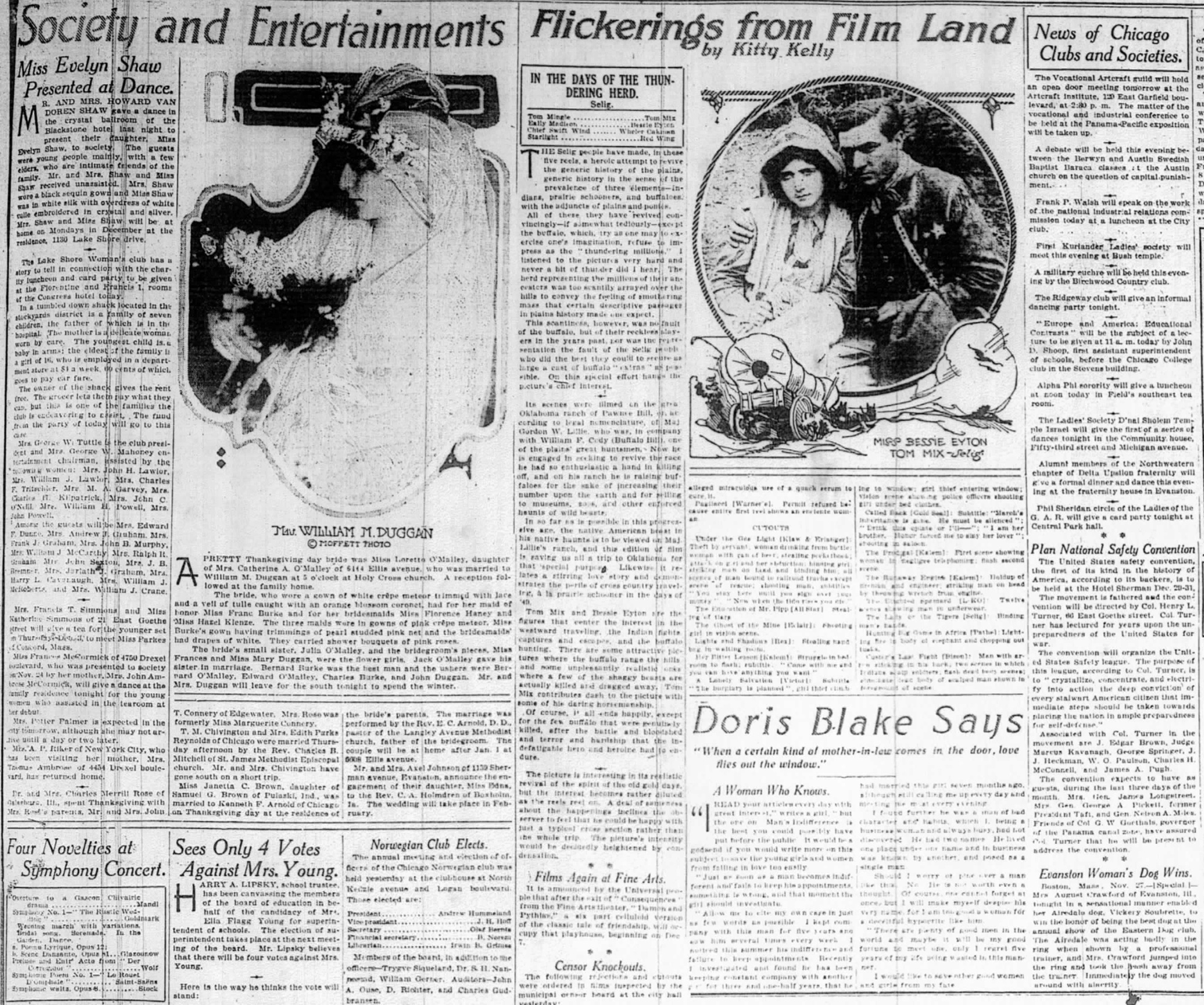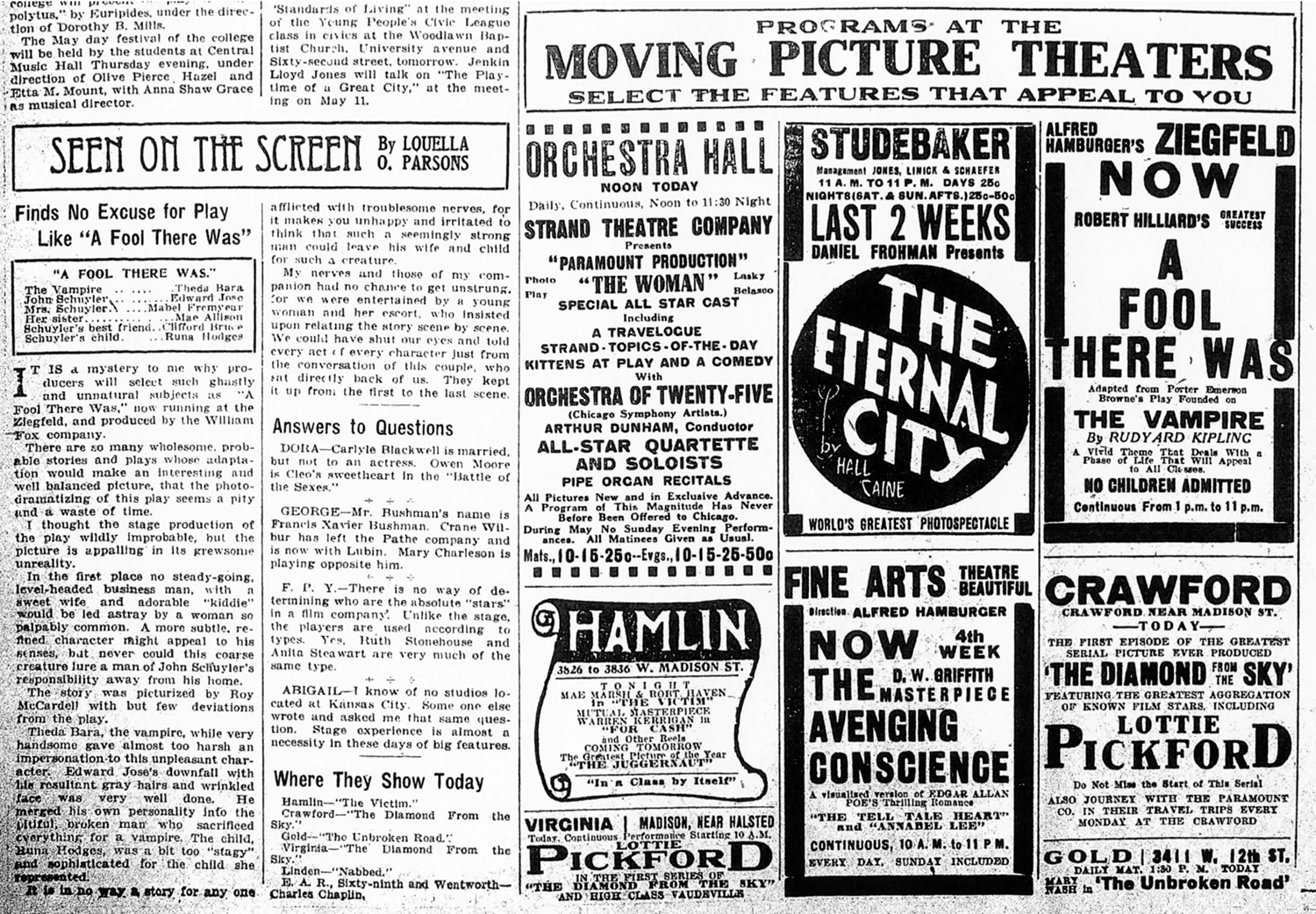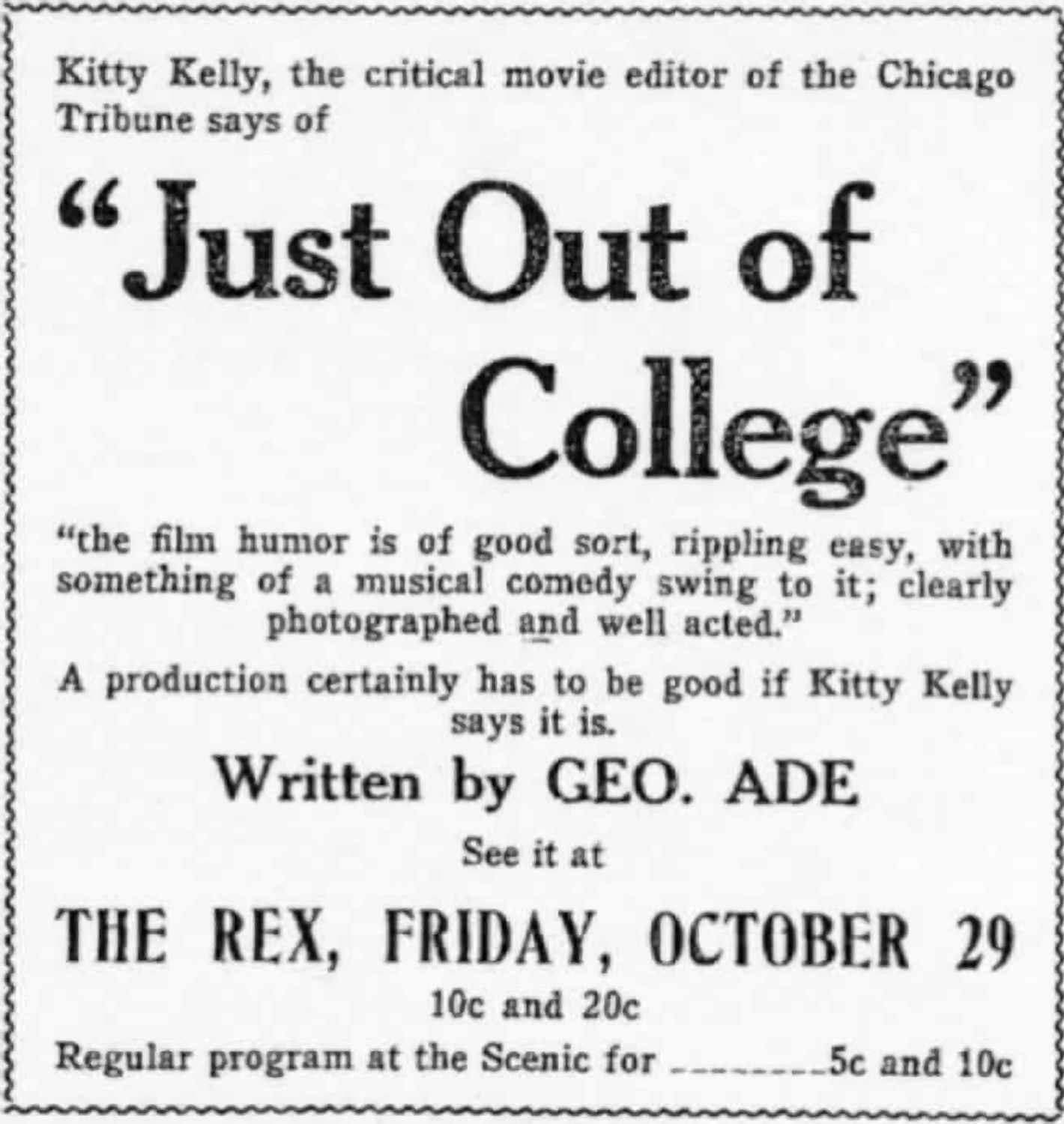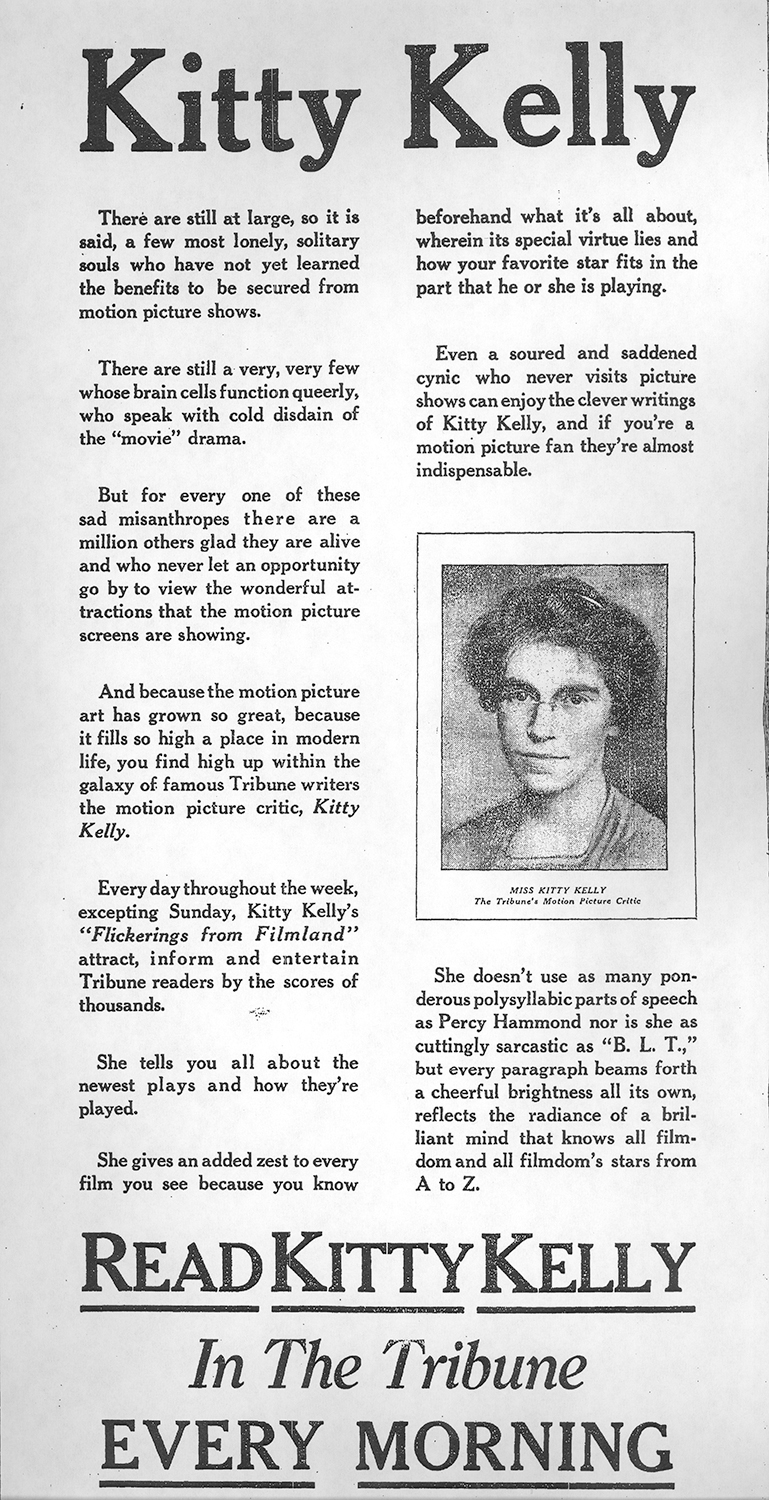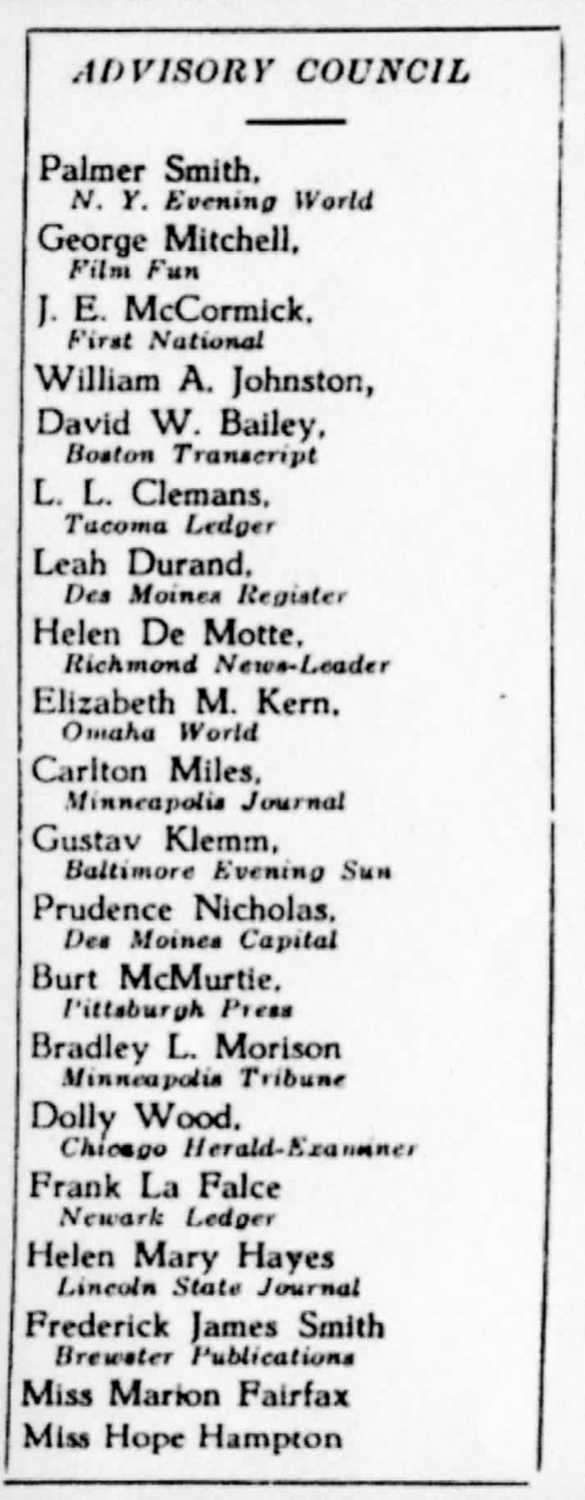Over the past few years, I have been researching American newspaper writing about motion pictures in the early and mid-1910s. That research has led me to argue that (1) newspaper writing played a crucial role in creating a popular film culture that supported and sustained the new industry’s spectacular growth as a mass entertainment; and (2) women, many long forgotten, were engaged in much of that writing. In this essay I want to analyse the work of eight women writers and frame that analysis according to three assumptions. First, “taking a newspaper” had, by the early 20th century, become a modern ritual in the “everyday life” of many Americans. Second, newspaper journalism was now a relatively open field of professional employment for women. And third, the women who began writing about motion pictures did so as reporters, columnists, editors, and reviewers. Let me expand briefly on those assumptions. [figure 1]
According to a key 1923 essay by sociologist Robert E. Park, the newspaper made any city “habitable, [made] it feel local and coherent. ” Its primary function was to offer “menus” or maps by which its readers could make sense of the complexity of modern urban life and imagine how to order and interpret their own daily lives. [1] A newspaper, John Nerone and Kevin G. Barnhurst write, “looked like an authoritative representation of the social world . . . streamlined in appearance and displaying clear hierarchy and segmentation,” which served “to enable groups of people to live together as a community (if not actually, then at least in their imagining).” [2] National industries gradually came to view not only mass magazines but also regional and metropolitan newspapers, supported by the railroad and telegraph, as a means of realising a vision, in Richard L. Kaplan’s words, of “American society made uniform and harmonious through standardized mass production and consumption.” [3]
Just as department stores systematised retailing into categories (and spaces) and restaurants did something similar with menus, so did newspapers have to find a way to manage an ever-growing flow of information that continually had to be turned into “news.” The answer: departmentalise the newspaper into separate pages or sections, often with their own heads for ease of access. Especially in the Sunday or weekend newspaper, those pages expanded into half a dozen or more sections and were well in place by the late 19th century. [figure 2] A metropolitan Sunday paper such as the Chicago Tribune had sections devoted to national and international news, editorials and local news, business and/or real estate matters, society events, women’s activities, children’s games, arts and amusements, and sports, along with a magazine and comics. Between 1905 and 1910, a new section on automobiles emerged; a few years later came a second on motion pictures, both in conjunction with those industries’ rapid development. If the section on automobiles targeted men, that on motion pictures tended to cater to women, whether aligned with the Women’s or Society sections or those devoted to arts and amusements. [4]
Many Sunday sections not only were full of “women’s interest” material but also were often written and/or edited by professional women. In 1892, Foster Coates, the city editor of the New York Journal, wrote in Ladies’ Home Journal: “The young woman with a good constitution, who knows how to write good English and is willing to work hard has as good an opportunity as any man similarly equipped to succeed in journalism.” [5] At the San Francisco Examiner, for instance, Annie Laurie was portrayed as a model “girl reporter” who covered any kind of news story in a style of “vivid, personal writing that was highly charged with emotion” and marked by “short sentences and paragraphs with hard jolts.” [6] Some women became popular for daily advice columns in William Randolph Hearst’s national chain of papers – for example, Beatrice Fairfax. [7] [figure 3] A few others were well known as drama critics – such as Amy Leslie of the Chicago Daily News – or press agents – for example, Nellie Revell for Percy Williams’ vaudeville circuit. [8] In all, by 1910, more than 4,000 women held writing and editing jobs, largely at newspapers. [9] “Their work,” historian Alice Fahs argues, “shaped new public spaces for women within the physical pages of the newspaper.” [10] It’s no wonder that so many newspaperwomen entered the motion picture news field.
The professional newspaperwomen I have selected to analyse took up writing about motion pictures from different perspectives. Let me categorize those according to a modified version of what Jan Olsson has called several “stages of media interaction.” [11] They include (1) the flâneuese whose gaze momentarily fastened on this new form of mass entertainment, (2) the columnist who contributed a frequent, even daily, diet of personality profiles of current movie stars, (3) the editor who filled out a special weekly page by selecting and arranging all kinds of material of supposed interest to moviegoers, and, finally, (4) the writer who took on the task of offering daily “independent” film reviews that might help readers to become better informed and discerning spectators.
The professional newspaperwoman as flâneuese
In late December 1911, the San Francisco Bulletin introduced a full Saturday page bannered “In the Land of Photoplays and Players.” [12] [figure 4] So tightly packed was this page that readers must have had trouble ingesting the wealth of information. The writer and editor, Ona Otto, was taking note of an unfamiliar phenomenon, so her tour of this new “land” included short interviews with local picture theater managers, and her “editorial” focused on observing an audience, whose anxious outbursts and hearty laughter quickly made her want “to find out more about these pictures.” Summarising moving pictures’ progress, she singled out several actresses – Sarah Bernhardt, Mabel Taliaferro – and costly films – The Passion Play, The Fall of Troy, Dante’s Inferno. These led her to shift from flâneuese to social reformer at the editorial’s conclusion, commending the city’s exhibitors and envisioning a future when “Moving Picture houses” will be accepted “on the same scale as legitimate theaters.” In the half page Otto wrote and edited each Saturday through January 1912, [figure 5] she promoted moving pictures and picture theaters for children, promising to print selected brief stories from children under 14 about a picture they especially liked. [13] Perhaps to placate readers, she also followed the earliest fan magazine in highlighting one large star photo profile each week. In later editorials, she interviewed the first moving picture entrepreneur; suggested ways to improve lobby displays; and warned that the chance of any girl or boy actually becoming a movie actor was very small. This half page disappeared after January, but Otto continued writing a “Window Shopping” column and then turned her attention to real estate, automobiles, farming, etc. [14]
The professional newspaperwoman as syndicated columnist
Beginning in November 1912, the Scripps-McRae newspaper chain introduced the first syndicated column of short “personality sketches” that could be picked up by United Press (UP) service clients across the country. [figure 6] The writer was a pioneering journalist located in Chicago, Gertrude Price, “YOUR ‘MOVIE’ EXPERT,” who regaled readers with stories about the “MOVING PICTURE FOLKS.” [15] Having already written extensively on Price, I’ll simply summarize a couple points here. [16] She wrote in the colloquial language of UP’s distinctive “colorful, readable copy,” with “punchy” headlines, and consistently used the slang term “movies” rather than “photoplays” as a direct appeal to the “bright youngsters [who] gave moving pictures an apt, vivid name.” Almost exclusively focused on American actors, two thirds of them women, her stories were illustrated with halftone images that usually emphasised their faces. Appearing irregularly, but frequently, often at the top of a page (and even on the front page), [figure 7] her stories circulated much like the movies and suggested that stars or “picture personalities” were even more important than company brands or “genres” of films for attracting moviegoers. Because Scripps-McRae newspapers, according to Gerald Baldasty, paid special attention to women readers, especially those of the “lower classes,” Price’s column likely assumed a targeted readership. [17] For more than a year, Price may have been one of the most widely read sources of gossip and information on the movies’ emerging stars.
Shortly before Price’s column became occasional in the spring of 1914, the Chicago Sunday Tribune gave a boost to readers’ fascination with stars in the “Right Off the Reel” page, written by Mae Tinee (Frances Peck). [figure 8] Its central feature was “In the Frame of Public Favor,” an unusually large publicity photo and profile of a current picture personality. Much like the huge close up of a movie star on screen, this image could be said to enact what Susan Stewart has called the “gigantic” in the period’s advertising. The first captioned profile of Kathlyn Williams, the star of Selig’s The Adventures of Kathlyn, mixed information and gossip: she was “of the Anglo-Saxon strain – fair-haired and blue eyed” and “courted a dangerous situation for the sheer spice of novelty,” describing that as “all in the day’s work.” [18] Readers were asked to mail in ballots naming their “favorite player” and each week’s photograph (and brief profile) was of the player who received the most votes. Their choices in the first few weeks suggest what stars were favored by Chicago’s movie fans: Mary Pickford, J. Warren Kerrigan, Alice Joyce, Florence LaBadie, Maurice Costello, and Pearl White. And fans had specific interests: both Costello and Pickford were “married”; “Kerrigan live[d] in Hollywood, Cal., with his mother”; and LaBadie was known for her “pet fad [of] sketching her friends.” [19] Except for Pickford, all performed chiefly in one- or two-reel films – that is, as frequently recurring figures in the variety package programs of General Film, Universal, or Mutual.
Complementing these “close up” profiles were several columns in which Mae Tinee solicited readers’ questions about “inside facts” of “the motion picture field.” [figure 9] “Gossip of the Silent Players” focused on “the life of your favorite actor and actress outside the films”: “Mary Pickford, Vivian Prescott, and Lillian Gish all worked together once as stage children”; and “Ethel Clayton (Lubin) is a fiend for motoring.” [20] Her signed column, “Answers to Movie Fans,” offered information on fans’ favourites in production: “[Kathlyn Williams] has a scar on her forehead caused by a leopard”; and “The ‘Mutual Girl’ series . . . show actual scenes [in New York City] and the prominent people are real.” [21] That [same year], “Gossip of the Movie Plays and Players” was retitled “In Movieland” and now included longer stories of humorous deception. In one, Norma Talmadge left the set of Vitagraph’s A Question of Clothes one day still cross-dressed as her character: on the street she flirted with a woman (and nearly got trounced by her male escort); nonplussed, she “treated” two other young women “in the regulation boyish manner.” [22]
By early 1915, the Sunday Tribune was expanding its coverage of movie fans’ fascination with movie stars. In January, Mae Tinee visited Essanay’s Chicago studios to interview the company’s new acquisition from Keystone, Charlie Chaplin. [figure 10] By February, she had to extend the “Right Off the Reel” page with a “Latest News from Movie Land” column in the Dramatic section. There too stars were the “news”: Leah Baird “received from an unknown girl admirer in Marion, Ind., a book illustrating the story of her life in pictures clipped from numerous publications”; and Kathlyn Williams’s name was being attached to everything from babies, a waltz, and a song to a perfume, a cocktail, and a “watch charm for single men.” [23] Beginning with Pickford’s photo, each week’s edition now included a “handsome insert, on special paper, all ready for framing FREE.” [24]
Also in early 1915, the Chicago Sunday Herald followed the Tribune’s lead with not one but three columns partly devoted to movie stars. Gene Morgan wrote the first based on an interview with Chaplin, followed by others at Selig’s Chicago studio. [25] Rosemary Grey composed brief star profiles called “His Hobby” or “Her Hobby,” accompanied by a silly graphic that literalized the title. [26] [figure 11] In April, Caroline Carr began writing a weekly star profile – with a prominently centred close up, like that of the Tribune – and headlined by catchy phrases reminiscent of Price: “Ruth Roland Breezily Mixes Tea and Business.” [27] In March, Louella Parsons, a scriptwriter for Essanay, introduced a daily film review column, “Seen on the Screen” – more on it later – that included a section on “Answers to Questions,” most of which were about stars. [28] She too conducted a few interviews. [29] Prodded by readers, she asked Kathlyn Williams and Francis X. Bushman exactly how many fan letters they received – 500 to 1,500 a week, they revealed. [30] [figure 12] Like Otto, she seemed concerned for the young girls hoping to make it in the movies: one already acting as an extra she warned not to “complain because someone in the studio spoke sharply to you” for “thousands of pretty girls” are ready to replace you. [31] Instead, Parsons’ advice was to praise one fan for her “splendid idea [of] saving all the pictures from the Herald rotogravure section for a scrapbook” [32] – as Edna Vercoe and her high school girlfriends in Highland Park (north of Chicago) already were doing.
In June 1915, Parsons began giving readers even more information about industry figures, especially stars. She conducted frequent interviews in Chicago: with Geraldine Farrar, nibbling roses for breakfast, as she stopped on her way to California; and with Lois Weber who was filming Olga Pavlova in the Sans Souci amusement park. [33] [figure 13] Parsons’ crucial coup was to publish a weekly series in which major stars told “The Story of My Life,” assisted by either a press agent or Parsons herself. The series included Kathlyn Williams, Lilian Gish, and Clara Kimball Young – each story graced by a large studio photo. [34] The most important, undoubtedly, was “The Story of My Life by Charley Chaplin,” whose six instalments ran from July into August, making Chaplin the city’s most publicized movie star. [35] [figure 14] After a one-month hiatus, Parsons resumed her stories, but now, as “the intimate friend of practically all the great stars,” she turned them into successful models for a new series, “How To Become a Movie Actress.” [36] Tellingly, all but one story featured young women, and Parsons no longer seemed intent on disabusing aspiring fans of their dreams.
As the “Daily Talks by Mary Pickford” column circulated widely across the country in late 1915, another daily column with a more limited range whetted fans’ appetites for gossip. This was Daisy Dean’s daily “News Notes from Movieland” distributed by the Central Press Association, beginning in January 1916, to Midwest newspapers. [37] [figure 15] Her name was the pseudonym of a yet-unknown young woman, who perhaps derived it from the main character in Lois Weber’s Scandal (Universal, 1915). [38] When the La Crosse Tribune (Wisconsin) began running Dean’s column, it was identified, as was Price’s, specifically for women and girls. [39] “News Notes” also bore similarities to Price’s earlier column not only for its frequency but also for its chief feature, the photo profile of a single movie star, usually in close up. Although Dean eschewed the punchy, slangy heads that characterised Price’s pieces, she sometimes worked in brief quips. In April, she shared a bit of studio slang: a “lens louse” was a new picture player who “insisted on stealing the foreground” of a shot. [40]
The items that Dean sifted out for her readers ranged far and wide. Most were informative, but she could be whimsical: strolling frequently through Chicago’s loop, Henry Walthall “invariably returns home with an odd assortment of lead pencils, shoe strings and such.” [41] Her choice of photo profiles clearly followed Price’s precedent by featuring women. Much like Price, Dean highlighted stars who not only were beautiful – i.e., Mary Pickford, Norma Talmadge, Theda Bara – but also were unusually versatile and loved “dare-devil” roles. [42] Louis Glaum learned to fly airplanes, [figure 16] and Cleo Madison had in different films “fought on the edge of cliffs, leaped from speeding express trains, plunged from burning buildings into nets, [and] leaped from a fast-going automobile onto the rear platform of the California Limited.” [43] Dean also called attention to Lois Weber and Ruth Stonehouse’s work as writers and directors as well as actors. [44] And she warned young girls that movie acting was arduous by posting Clara Kimball Young’s daily routine: arise at 7:00, work from 9:00 to 5:00 at World Film’s studio, and often “visit various theaters” screening one of her films to “delight her audience by appearing in person.” [45]
The professional newspaperwoman as editor
Weekend pages devoted to motion pictures did emerge between late 1911 and late 1913, but none would have the impact of the Chicago Tribune’s “Right Off the Reel,” edited by Mae Tinee. First introduced on 1 March 1914 in the Tribune’s colour Sunday magazine, “Right Off the Reel” prominently featured “In the Frame of Public Favor,” with its “close up” publicity image and profile of a current star. [46] In mid-April, two new columns appeared, signaling that the page would be devoted to, not photoplays, but movies. One, “Answers to Movie Fans,” purported to address readers, whose questions, not unsurprisingly, dealt with stars. [47] The other, signed by Mae Tinee and written in the breathless tone of “Zip! Zam! Zowie!,” recounted her experience as an “extra girl” at Essanay’s Chicago studio, interviewing William Selig, and then talking with actors at studios in and around New York City. [48] [figure 17] Not until May was Mae Tinee identified as the writer of “Answers to Movie Fans,” and her other column was renamed “Gossip of the Movie Plays and Players.” [49] By September, “Right Off the Reel” also began offering a forum for letters: “The Voice of the Movie Fans.” Whether initialed or ventriloquized, this voice often registered fans’ complaints: from censors’ lack of concern for “ the physical abuse of women by men” to the vulgarity of Keystone’s comedies. [50] Only in January 1915 did Mae Tinee finally sign the “Right Off the Reel” banner as editor – and author – of the entire page. [51] Earlier that month, as a promotional stunt, the Sunday Tribune editor put Mae Tinee in “The Frame of Public Favor” as that week’s most “popular player.” [52] [figure 18]
Throughout 1915, “Right Off the Reel” held to a relatively standardised format: a prominent “close up” movie star profile framed by familiar columns on three sides, a bottom corner comic strip, and an appeal to fans to vote for their “favourite player.” In April, Mae Tinee promoted motion pictures with two full-page stories targeting middle class adults: in one, a waiter advises a luncheon club of businessmen where to find the best information on picture theatres; in the other, a businessman’s wife gets similar advice from her neighbour women about how to treat a visiting school friend. [53] [figure 19] The Tribune recognized her as a valuable asset when ads for its Sunday edition listed “Right Off the Reel” as a top weekly feature. [54] Perhaps because all or some of “Right Off the Reel” circulated through the Tribune’s syndicated service to newspapers in Buffalo, Augusta (Georgia), Fort Worth, and Oakland, [55] Mae Tinee very likely was the first well known, influential “movie menu” editor/writer in the country.
One month after the Tribune, the Chicago Record-Herald introduced its own Sunday page called “Reel Drama.” [56] Initially it combined industry stories with others of local interest, but gave slightly less attention to stars. [57] In late May, the page adopted a new banner “In the Picture Playhouses” and, after an article in imitation of Mae Tinee’s experience as an “Extra Girl,” [58] took a more exclusive interest in industry news and gossip.” [59] Although “In the Picture Playhouses” shrank to half a page on summer Sundays, [60] just before Labor Day the full page returned, showing more interest in local matters, for example, several “Extra Girl” articles. [61] By early 1915, the Herald’s Sunday page – now bannered “From Filmland” [62] [figure 20] – was competing with the Tribune’s on nearly equal terms, likely the result of three writers: Morgan, Carr, and, most important, Parsons.
A full-page ad had promoted Parsons when, in December, she began writing a weekly “How To Write Photoplays.” [63] [figure 21] After wrapping up this long-running column in June 1915 – soon collected into a book [64] – Parsons began interviewing well-known stars for prominent photo profiles, beginning with Lillian Gish and Clara Kimball Young. [65] In September, these profiles turned into the series already mentioned above, “How To Become A Movie Actress”, that, rather than enticing young female readers, offered “behind the scenes” stories of how “the most well-known moving picture stars won success.” [66] Very shortly, Parsons gave her series an even more provocative title, “How To Become A Movie Star”, and almost exclusively chose women to profile. [67] Unlike the Tribune, the Herald seems not to have thought “From Filmland” all that important for readers: a full-page ad ranked it low in a list of the Sunday Herald’s features. [68] Yet, because Parsons finally was identified as the editor of “From Filmland,” which circulated as far west as Oakland and Boise (Idaho) throughout 1915, [69] she clearly was becoming nearly as well known as Mae Tinee. [figure 22]
Among those who edited regular pages devoted to motion pictures, let me briefly mention another Midwestern woman, Dorothy Gottlieb. [70] From August 1915 on, the Des Moines Tribune printed a daily, unsigned “News of the Movies” column that often had notes on films booked in the picture theatres advertising in the paper, along with bits of industry news. [71] In November, the Tribune expanded its coverage to a full Wednesday page, with the alliterative banner, “Flickerings and Flashes from Filmland.” [72] [figure 23] There, columns described the programs at half a dozen picture theatres supporting the page with ads and offered local news such as the organization of a “Film Club by the city’s motion picture fans,” sponsored by the Business Women’s Clubs. [73] As in other papers, this page regaled readers with information on stars: one column praised Pickford for being the first to “exploit her hair with halo light effects” (back lighting); another compiled the amazing stunts that Helen Holmes pulled off in the serial, The Girl and the Game. [74] In late January 1916, the Tribune dropped the “Flickerings and Flashes from Filmland” page and instead began adding sections to the daily “News of the Movies.” First was a “Questions and Answers” column, inviting letters addressed to the “Photoplay Department.” [75] Next came “Plays and Players” that separated all the industry news and gossip into a third section. [76] Only in late February was Gottlieb given an alliterative byline for these columns as Dorothy Day. Now “Questions and Answers” became “What Do You Want to Know About the Movies?” (as if directly addressing each reader), and “Plays and Players” turned into a lengthy column that led into the first of half a dozen or more stories. [77] In late March, a line drawing of Day looking straight at the reader replaced her byline; two weeks later, she was identified – as were Mae Tinee and Parsons before her – as the editor/writer of all the material beneath the banner, “News of the Movies.” [figure 24]
The professional newspaperwoman as film reviewer
For decades newspapers had offered readers, usually in Sunday editions, reviews of current books, stage plays, operas, and art exhibitions as high culture. If men tended to write reviews of stage productions, those dealing with print fiction often were seen as “women’s work.” [78] The primary aim of such reviews aligned with Progressive principles of social and cultural uplift: they “trained” readers, as Charles Johanningsmeier writes, to accept their standards of appreciation and thus learn how best to read and understand artistic texts, works, and performances. [79] What movie fans could not find were reviews of individual films. That is, until the first half of 1914, when several newspapers began featuring movie review columns in tandem with the new Sunday motion picture pages.
Of these, the Chicago Tribune introduced the first – and arguably the most influential – a column that emerged out of “Today’s Best Moving Picture Story,” [80] which highlighted a few plot synopses supplied by the industry. On July 1, Kitty Kelly was identified as the writer, who, under her real name, Audrey Alspaugh, dabbled in book reviewing for the Tribune’s Sunday editor, Mary King. [81] Now the column found a regular space on either the Society or Woman’s page, retitled “Photoplay Stories and News,” and her reviews focused on a single film. [82] [figure 25] In the fall of 1914, the title underwent another change to “Flickerings from Film Land by Kitty Kelly.” [83] By November, readers could find Kelly’s column more often, and eventually daily. These changes seemed to mark the Tribune’s dawning recognition that the movies, in more ways than one, were creating an American fantasy space of desire and imaginary participation. In early January 1915, a full-page ad confirmed this recognition by displaying photos of its writers and artists, with both Kelly and Mae Tinee among them as “experts” writing about moving pictures. [84]
One thing that must have snagged readers’ attention was Kelly’s playfully exuberant style. Vitagraph’s Lost in Mid-Ocean “heaps up more horrors on a lone woman’s head than one would expect twenty of even the strongest feminine examples to endure.” [85] She clearly enjoyed spinning out tongue-in-cheek metaphors. The unusually skilful plot in Bison’s The Forbidden Room was “as essential to the perfect knitting of the whole as [is] a single stitch in a silk stocking.” [86] This love of language, verging on “showboating,” produced a savoury put down of Selig’s The Real Thing in Cowboys, starring Tom Mix: “a pudding full of the conventional plums of love and effort and accomplishment, tinctured with a dash of slapstick fun.” It also led her to chastise companies for giving pictures “names about as attractive and suitable as a fur coat in August.” [87] These quotes imply that her readers were women: note her delight in deflating a puff piece on Francis X. Bushman’s addition of “an amethyst colored automobile to his collection of ‘jewels’ […] My goodness Gracious, Girls! Isn’t He Lovely!” [88]
From very early on, Kelly displayed a keen interest in the choice, construction, and tone of a film’s narrative: much like a book critic, she deployed those as principles for evaluating a film’s “artistic” worth. The “complicated plot and well sustained suspense” of Majestic’s The Double Knot conferred on the cinema “real rank as a narrative type, such that it equals in interest many magazine stories.” In early January 1915, she found that Lasky’s The Girl of the Golden West had all the “essentials of a successful entertainment”: “excitement and suspense of a logical sort,” “heroism and humor and love,” “attractive atmosphere,” and “star personalities.” [89] [figure 26] Months later, she wrote: Lasky’s The Woman, adapted from a William DeMille play, “gives opportunity for development of both character and atmosphere, and the observer follows the moods and emotions of the players [because] the situations all have point, and they are crisp – cut off just before one begins to feel there is a touch too much.” [90] Despite her aversion to slapstick, Keystone’s Tillie’s Punctured Romance allowed her to study why audiences erupted in continual “shouts of laughter.” [91] Increasingly, Kelly began to pick out specific details to highlight in a film. In Famous Players’ The Morals of Marcus, “the subtitles contribute much to the humor of the whole, their crisp pointedness assisting the action every time.” [92] In World Film’s Alias Jimmy Valentine, she noted the unique perspective of the crime scene, where, “on a scaffolding high up near the roof of the studio,” over a bank interior set, Maurice Tourneur “filmed the action … showing a very exciting chase and fight in the various rooms.” [93] [figure 27] In the summer of 1915, she began to recognize the value of “effective close up after effective close up” in Lasky’s The Clue, where Sessue Hayakawa’s “marvelous face” distracted her “with its slow narrowing of narrow eyes, its flicker of flexible lip.” [94] All these led Kelly to conclude: “pictures nowadays have their special styles of diction, just as does fiction.” [95]
Joining this pioneer in 1915 were two other writers: Parsons in the Chicago Herald and “The Film Girl” in the Syracuse Herald. In mid-March 1915, Parsons began signing a column entitled “Seen on the Screen,” starting with a review of Essanay’s In the Park, in which she concisely caught Chaplin’s “ridiculous goose-walk stunts, kicking right and left with his No. 12 shoes, in the most matter of fact fashion.” [96] Much like Kelly, she chose just one film to review. Her initial columns revealed a wide range of interests, and several became characteristic: a preference for feature films, especially stage play adaptations, an attention to actors’ skills, a shared appreciation of local audiences, and a sense of moral approbation. In Famous Players’ Are You a Mason?, John Barrymore brought “a laugh from the first peep we have of him as the dutiful husband until the last bit of film fades from our sight.” [97] Her interest in audiences led her to note the applause for “the scenic portions” of Famous Player’s The Eternal City and quote a young woman seated next to her who had lived in Rome: “They are by far the best pictures I have ever seen of the Italian city.” [98] Her moral sense was much offended by World Film’s The Fight, largely because “the story [was] sordid and unwholesome and not the sort of material the censor board has educated us to expect on the screen.” [99]
Within weeks, the Herald located Parsons’ column on the Society or Women’s page, much like Kelly’s. She found more pictures to condemn, although crowds flocked to them: Three Weeks, based on “Elinor Glynn’s salacious book,” was an inexcusably “immoral tale”; not only was Fox’s A Fool There Was “appalling in its grewsome [sic] unreality,” but Theda Bara also “gave almost too harsh an impersonation of her unpleasant character.” [100] [figure 28] Critical of the industry practice of adapting “unsuitable” magazine stories for the screen, Parsons played the constant advocate for feature film adaptations. Especially favored were: Famous Players’ Fanon the Cricket, with “Mary Pickford, sweet and winsome in all her rags”; and Selig’s The Carpet from Bagdad, “a fanciful story, but told in a clear, concise way that makes one realize the day of big features is at hand.” [101] Such films provoked her to confess that each week she was “more and more impressed with the wonder of it all.” [102] As further evidence she wrote of viewing Mutual’s The Avenging Conscience not once but three times, deftly describing “the delicate touches, the beautiful scenic effects and the stirring suspense” that so characterized D.W. Griffith’s direction. [103]
The daily column that the Syracuse Herald began running in June 1915 resembled its predecessors in format yet its differences soon were apparent. Also titled “Seen on the Screen,” it was signed by “The Film Girl,” [104] a young woman finally identified in late 1918 as Marjorie Dunmore Tooke, when she set sail for France as a YMCA secretary in overseas service. [105] [figure 29] The Film Girl addressed readers in a colloquial, chatty, personalised style that, unlike Kelly’s, rarely called attention to itself: she was simply a “maid of the movies.” During the week, the column could be paired with a piece of serialized fiction; on Saturdays it could nestle near a schedule of church events; by November, it frequently occupied the same page as “Daily Talks by Mary Pickford.” [106] [figure 30] From early on, The Film Girl confessed a liking for a local variety program of short films: “After I have seen a really good old fashioned kind of a movie show consisting of a two reel feature and about three good one reel photo plays, I am inclined to think that I’d just about as soon go in the 5-cent theater as in the 15-cent one.” [107] And she aligned herself with fans by lauding one neighborhood theater for “showing feature pictures which are not altogether new” because “not all those who would have liked to were able to see them” when first screened. [108]
Yet feature films usually received The Film Girl’s more sustained reviews. Unlike Kelly and Parsons, she was not concerned with films as art, nor did she “claim that they are instructive or that they benefit one mentally … Their mission is as a diversion – a relaxation. Therefore, we need them in our lives.” [109] Accordingly, her appreciation of a feature could be impressionistic. “I laughed aloud during the greater part of ‘Chimmie Fadden,’ which is my method of conveying the impression of what an excellent production I think it is.” [110] One of the few Famous Player features starring Pickford she thought up to the standard set by her earlier films was A Girl of Yesterday: “a pleasant vehicle built just her size – a rambling vehicle – sweet and without plan as were our grandmothers’ gardens,” leaving “a fragrant memory.” [111] The Film Girl also was fascinated with other stars. Geraldine Farrar enthralled her in Lasky’s Carmen, but she most admired the “wickedly beautiful” Theda Bara – as in The Devil’s Daughter, which forced people to wait “three quarters of an hour to get inside the lobby,” and Destruction, in which “Mephistophelian glee sends strange, distorted smiles” across her visage “as victim after victim is subdued.” [112] She also promoted prominent women in the industry. In praising Universal’s Scandal, she credited Lois Weber – along with Phillips Smalley – as writers, directors, and stars. [113] Grace Cunard she singled out as “the author of 400 scenarios,” including the serials, Lucille Love and The Broken Coin. [114] Others who caught her attention: Alice Guy Blaché, who directed Anna Petrova in Metro’s My Madonna, and Cleo Madison directing herself in Universal’s A Mother’s Atonement. [115]
The Film Girl was unusually forthright in sharing her practices as a reviewer and her observations on movie-going. Advance notices and starting times concerned some of her “regulars.” “A country woman, the mother of a growing family, and an ardent devotee of the movies” wrote one manager asking that he advertise “a day ahead in the newspapers,” so she could plan long trips into the city. [116] She herself warned fans that, to follow a fine film’s complicated story, one had to arrive at the beginning. [117] During a screening of Vitagraph’s The Sins of the Mothers what she noticed was the “many women who obviously had come because the name of the piece suggested something which they should see – and how greatly they enjoyed themselves once they were there.” [118] Yet she could also pose as an “instructor” of proper behavior. Prompted by the conditions one rainy day – “aisles littered with protruding ends of wet umbrellas and paved with small rain water puddles through which run a succession of foot tracks both large and small, and a damp rubbery atmosphere” – she gently prodded moviegoers “on how to enter a motion picture show and sit down, and how to arise and leave without bumping against the heads of the people in the row in front.” [119]
Professional newspaperwomen, exhibitors, and spectators
Let me wrap up this essay with two points. First, exhibitors elsewhere soon exploited the views of all three Chicago newspaperwomen. Cited most often in theatre ads and promotional pieces was Kitty Kelly. Beginning in March 1915, Kelly’s choice phrases lured movie fans from Madison (Wisconsin), Waterloo and Glenwood (Iowa), and Rockford (Illinois), to San Jose (California). [figure 31] Six months later, readers in two of those cities could find Louella Parsons’s take on Theda Bara in Fox’s Sin. In early 1916, those in Logansport (Indiana) could hardly miss Mae Tinee calling Photo Drama’s How Molly Made Good “A Hit!” By then, an unusually large Tribune ad was celebrating Kelly and her “clever writings”: “if you’re a motion picture fan they’re almost indispensable.” [120] [figure 32] Second, by early 1915, both Kelly and Mae Tinee were cognizant of a new sense of absorption in the screen world conjured by a film. Lasky’s Stolen Goods, Kelly wrote, had “such a careful manipulation of the suspense threads, such skillful selection of the high lights of interest, such compactness and yet such completeness that … the observer comes as near to sharing the vital experience of any third person as he can come in life.” [121] When Mae Tinee briefly took over Kelly’s column, she too found herself absorbed in Griffith’s The Avenging Conscience, “oblivious to everything except that which is transpiring so swiftly on the screen.” “You are THERE with Henry B. Walthall in his love, in his shame and suffering, in his crime,” she exclaimed, “and with him you suffer the tortures of fear and remorse that makes his life a hideous thing.” [122] Their language of rhetorical vividness or illuminative liveliness, making a film come alive for readers, [123] confirms that, by the mid-1910s, motion pictures were attracting a singularly engaged spectator, and it also seemed to position that spectator before the screen world and its elusive figures, as both there and not there, in a state of rapt attention and absorption. [124]
Coda
And here are some other women worthy of further research. Several from the 1910s could not be included in this essay: Mary B. Leffler at the Fort Worth Star-Telegram, Ruth Vinson at the Cleveland Plain Dealer, and Harriette Underhill at the New York Tribune. [125] In the 1920s, moreover, the Advisory Council of the New York Film Arts Guild listed no fewer than six newspaperwomen among its members, all but one from the Midwest: Leah Durand (Des Moines Register), Helen De Motte (Richmond News-Leader), Elizabeth M. Kern (Omaha World), Prudence Nicholas (Des Moines Capital), Dolly Wood (Chicago Herald-Examiner), and Helen Mary Hayes (Lincoln State Journal). [126] [figure 33]
Endnotes
[1] See, for instance, certain key essays from the Chicago School of Sociology in the 1920s: Robert E. Park, “The Natural History of the Newspaper,” American Journal of Sociology 29 (1923), 273-289; and Ernest W. Burgess, “The Growth of the City,” in R. E. Park, E. W. Burgess, and R. D. MacKenzie, eds., The City (Chicago: University of Chicago Press, 1925), 47-62. For excellent examples of how this concept of daily newspapers’ function can be applied to early cinema, see Paul S. Moore, “Everybody’s Going: City Newspapers and the Early Mass Market for Movies,” City & Community 4.4 (December 2005): 339-357; and Moore, Now Playing: Early Moviegoing and the Regulation of Fun (Albany: SUNY Press, 2008), 158-163.
[2] John Nerone and Kevin G. Barnhurst, “News form and the media environment: a network of represented relationships,” Media, Culture & Society 25 (2003): 112, 121. See also Benedict Anderson, Imagined Communities: Reflections on the Origin and Spread of Nationalism, 2nd ed. (London: Verso, 1991). At the time, John Baker Opdycke made this extravagant claim: the newspaper “is a school in and of itself. It instructs, not only the young, but the adult as well.” See Opdycke, News, Ads, and Sales: The Use of English for Commercial Purposes (New York: Macmillan, 1914), 3.
[3] Richard L. Kaplan, Politics and the American Press: The Rise of Objectivity, 1865-1920 (Cambridge: Cambridge University Press, 2002), 125.
[4] Targeting women, of course, went along with the rise in importance of consumption as a frequent, repeatable social activity, supported by advertising “for which women were conventionally more responsible than men”: Michael Schudson, Discovering the News: A Social History of the Newspaper (New York: Basic Books, 1973), 100.
[5] Quoted in Marion T. Marzolf, Up from the Footnote: A History of Women Journalists (New York: Hastings House, 1977), 29.
[6] Ishbel Ross, Ladies of the Press (New York: Harper & Brothers, 1936), 60-67; Marzolf, Up from the Footnote, 33-34; George H. Douglas, The Golden Age of the Newspaper (Westport: Greenwood Press, 1999), 182-183.
[7] Ross, Ladies of the Press, 74-83; Marzolf, Up from the Footnote, 36-37. See also A.C. Hasselbarth, “Women Writers of American Press,” The Editor and Publisher and Journalist (4 October 1913): 304.
[8] Ross, Ladies of the Press, 408-409; and “Woman Press Agent,” The Editor and Publisher (6 May 1911): 15.
[9] Marzolf, Up from the Footnote, 32.
[10] Alice Fahs, Out on Assignment: Newspaper Women and the Making of Modern Public Space (Chapel Hill, 2011), 1.
[11] Jan Olsson, Los Angeles Before Hollywood: Journalism and American Film Culture, 1905-1915 (Stockholm: National Library of Sweden, 2008), 69-98. Olsson’s “five stages of media interaction” in relation to motion pictures are reporter, Flâneur, social reformer, surveyer, and promoter and critic.
[12] Ona Otto, “In the Land of Photoplays and Players,” San Francisco Bulletin (23 December 1911): 4. Otto is identified as a young woman in “Ona Otto Talks of Photographs and Motor Cars,” San Francisco Bulletin (18 May 1912): 1. See also Epes Winthrop Sargent, “Advice to Exhibitors,” Moving Picture World (20 January 1912): 198.
[13] Otto, “In the Land of Photoplays and Players,” San Francisco Bulletin (30 December 1911): 7, (6 January 1912): 7, (13 January 1912): 8, (20 January 1912): 18, and (27 January 1912): 12.
[14] The February and March issues of the San Francisco Bulletin were missing from the microfilm reel I consulted. Ona Otto, “Window Shopping,” San Francisco Bulletin (30 January 1912): 8. Most of Otto’s other pieces appeared in the Bulletin’s “Automobile and Real Estate Section”: “Land on Way to Fresno From Kerman, a Wonder Picture, Says Miss Otto,” (6 April 1912): 25; Ona Otto, “Motion Slides Take Land to Buyers,” (11 April 1912): 7; “Miss Otto Talks Interestingly of Young Land Agent,” (13 April 1912): 18; “Buying in Kerman Is Road to Wealth,” (13 April 1912): 9; “Selling Real Estate Is Much Like Being a Doctor, Agent Tells Miss Otto,” (20 April 1912): 20; Ona Otto, “Beautiful Garden of Roses at Burlingame Soon to Be Subdivided,” (27 April 1912): 15; “Ona Otto Sees Great Picture in Havenscourt,” (4 May 1912): 16; “Ona Otto Urges Young Men to Take Up Farming,” (11 May 1912): 16; and “Ona Otto Talks of Photographs and Motor Cars,” (18 May 1912): n.p.
[15] “Here You Are Folks! All About ‘The Movies’,” Chicago Day Book (11 November 1912): 11; and “The Movies,” Des Moines News (11 November 1912): 2, and Cleveland Press (11 November 1912): 1.
[16] Richard Abel, Americanizing the Movies and “Movie-Mad” Audiences, 1910-1914 (Berkeley: University of California Press, 2006), 223-224, 241-247.
[17] Gerald Baldasty, E. W. Scripps and the Business of Newspapers (Urbana: University of Illinois Press, 1999), 143.
[18] In the Frame of Public Favor,” Chicago Sunday Tribune (1 March 1914): 5.3.
[19] “In the Frame of Public Favor,” Chicago Sunday Tribune (8 March 1914): 5.3, (22 March 1914): 5.3, (29 March 1914): 5.3, (5 April 1914): 5.3, (16 April 1914): 5.3, (10 May 1914): 5.3, and (21 June 1914): 8.3.
[20] “Gossip of the Silent Players,” Chicago Sunday Tribune (1 March 1914): 5.3.
[21] “Answers to Questions,” Chicago Sunday Tribune (15 March 1914): 5.3; “Answers to Movie Fans by Mae Tinee,” Chicago Sunday Tribune (12 April 1914): 5.3, and (19 April 1914): 5.3.
[22] “In Movieland,” Chicago Sunday Tribune (4 October 1914): 8.4, and (15 November 1914): 8.7.
[23] “Mae Tinee, “Latest News from Movie Land,” Chicago Sunday Tribune (7 February 1915): 8.5.
[24] See the full-page advertisement in the Chicago Tribune (27 February 1915): 7.
[25] Gene Morgan, “What Tyrone Power Thinks of Himself and the Celluloid Drama,” Chicago Sunday Herald (17 January 1915): 6.6; Morgan, “Auburn Haired Personality in Film,” Chicago Sunday Herald (31 January 1915): 6.7; Morgan, “In Reel Life But Not in Real Life,” Chicago Sunday Herald (7 March 1915): 6.6.
[26] Rosemary Gray, “His Hobby [Francis X. Bushman],” Chicago Sunday Herald (24 January 1915): 6.6; and Gray, “Her Hobby [Kathlyn Williams].” Chicago Sunday Herald (31 January 1915): 6.6. Later this column would adopt more conventional graphics.
[27] Caroline Carr, “Ruth Roland Breezily Mixes Tea and Business,” Chicago Sunday Herald (18 April 1915): 5.6; Carr, “Pretty Grace Darmond, Who Rides, Swims, Acts,” Chicago Sunday Herald (25 April 1915): 5.6; and Carr, “Essanay Star Says Movies Will Only Take Professionals,” Chicago Sunday Herald (2 May 19150: 5.6.
[28] Luella [sic] O Parsons, “Seen on the Screen,” Chicago Herald (20 March 1915): 14.
[29] Louella O Parsons, “Seen on the Screen,” Chicago Herald (1 April 1915): 12, and (10 May 1915): 8. Local industry leaders such as Aaron Jones, Alfred Hamburger, George K. Spoor, and Winfield R. Sheenan (Fox Film) more frequently were her interview subjects: see Louella O Parsons, “Seen on the Screen,” Chicago Herald (9 April 1915): 8, (12 May 1915): 10, (2 June 1915): 8, and (4 June 1915): 10.
[30] Louella O Parsons, “Seen on the Screen,” Chicago Herald (7 May 1915): 8.
[31] Louella O Parsons, “Seen on the Screen,” Chicago Herald (12 April 1915): 8, and (20 May 1915): 8; and Louella O Parsons, “Girls All Eager for Chance To Become ‘Movie’ Actresses,” Chicago Herald (24 May 1915): 8.
[32] Louella O Parsons, “ Seen on the Screen,” Chicago Herald (19 April 1915): 8.
[33] “Here’s $62 Talk by Miss Farrar,” Chicago Herald (9 June 1915): 2.1; Louella O Parsons, “Seen on the Screen,” Chicago Herald (11 June 1915): 8, (18 June 1915): 8, and (10 July 1915): 8. Parson also interviewed Samuel Goldfish, also on his way from Los Angeles to New York, and Adolph Zukor who was visiting the downtown offices of the Jones, Linick & Schaefer Company: Louella O. Parsons, “Seen on the Screen,” Chicago Herald (17 June 1915): 8, and (3 July 1915): 8
[34] “The Story of My Life by Kathlyn Williams,” Chicago Sunday Herald (13 June 1915): 5.2; “The Story of My Life by Edna Mayo, Chicago Sunday Herald (20 June 1915): 5.6; “The Story of My Life by Marguerite Clark,” Chicago Sunday Herald (27 June 1915): 5.6; Louella O. Parsons, “The Story of Lillian Gish – ‘Most Beautiful Blonde in the World’,” Chicago Sunday Herald (11 July 1915): 6.5; and Louella O. Parsons, “Here’s Ideal Film Personality – Clara Kimball Young Is Playful Child and Brainy Woman,” Chicago Sunday Herald (18 July 1915): 6.6.
[35] “The Story of My Life By Charley Chaplin,” Chicago Sunday Herald (4 July 1915): 5.6, and (8 August 1915): 5.6. See also Charlie Chaplin’s Own Story (Indianapolis: Bobbs-Merrill, 1916).
[36] Louella O. Parsons, “How to Become a Movie Actress,” Chicago Sunday Herald (19 September 1915): 6.1, and (26 September 1915): 5.6; Louella O. Parsons, “How to Become a Movie Star,” Chicago Sunday Herald (3 October 1915): 6.3, (10 October 1915): 6.6, (17 October 1915): 6.4, (24 October 1915): 6.3, and (31 October 1915): 6.3.
[37] Daisy Dean, “News Notes from Movieland,” Canton Repository (6 January 1916): 12; and “Listen! Movie Fans,” La Crosse Tribune (10 January 1916): 1.
[38] See, for instance, “Amusements,” San Antonio Light (31 July 1915): 8. Where Daisy Dean was located remains uncertain, although someone with that name is mentioned, about that same time, as having “left this morning for a trip to the Pacific Coast” from a town near Janesville, Wisconsin: see “Avalon,” Janesville Gazette (5 August 1915): 8.
[39] “News Notes from the Movies,” La Crosse Tribune (11 January 1916): 3.
[40] Daisy Dean, “News Notes from Movieland,” Canton Repository (1 April 1916): 10.
[41] Daisy Dean, “News Notes from Movieland,” Canton Repository (10 April 1916): 11.
[42] Daisy Dean, “Newsy Notes from Movieland,” Hutchinson News (14 February 1916): 12.
[43] Daisy Dean, “Newsy Notes from Movieland,” Hutchinson News (9 February 1916): 12, (8 June 1916): 8, (16 August 1916): 10, and (9 October 1916): 4.
[44] Daisy Dean, “Newsy Notes from Movieland,” Hutchinson News (26 May 1916): 14, (8 July 1916): 11, and (13 October 1916): 4. For a sustained analysis of these and other women working at Universal during this period, see Mark Garrett Cooper, Universal Women: Filmmaking and Institutional Change in Hollywood (Urbana: University of Illinois Press, 2010).
[45] Daisy Dean, “Newsy Notes from Movieland,” Hutchinson News (22 November 1916): 4.
[46] “Right Off the Reel” may have first appeared as the title of a weekly column in Exhibitors’ Times, beginning on 24 May 1913. The writer was T.B. or Thomas Bedding, one of the trade journal’s editors.
[47] “Answers to Movie Fans,” Chicago Sunday Tribune (12 April 1914): 5.3.
[48] Mae Tinee, “Babes in the Movie Zoo,” Chicago Sunday Tribune (12 April 1914): 5.3; and “Mae Tinee Writes from New York,” Chicago Sunday Tribune (19 April 1914): 5.3.
[49] “Answers to Movie Fans by Mae Tinee,” Chicago Sunday Tribune (31 May 1914): 5.3; “Gossip of the Movie Plays and Players,” Chicago Sunday Tribune (12 July 1914): 8.5; and Mae Tinee, “Gossip of the Movie Plays and Players,” Chicago Sunday Tribune (2 August 1914): 8.5.
[50] “The Voice of the Movie Fans,” Chicago Sunday Tribune (20 September 1914): 8.4, (27 September 1914): 8.5, and (4 October 1914): 8.4. “In Movieland,” Chicago Sunday Tribune (27 September 1914): 8.5, (22 November 1914): 8.11, (29 November 1914): 8.4, and (9 December 1914): 8.9.
[51] “Right Off the Reel by Mae Tinee,” Chicago Sunday Tribune (31 January 1915): 5.3.
[52] “The Frame of Public Favor,” Chicago Sunday Tribune (3 January 1915): 8.7. Whether or not one should trust this profile of Francis Peck (aka Mae Tinee) is uncertain, but an early biographical note claims she was the daughter of a Denver evangelist, served as a cub reporter on the Denver Republican, and, after a failed marriage, moved to Chicago to join the Chicago Tribune: see Ishbel Ross, Ladies of the Press, 411-412.
[53] Mae Tinee, “The Waiter’s Tip or A Discovery,” Chicago Tribune (17 April 1915): 8; and Mae Tinee, “What Saved the Day for Mrs. Lansing,” Chicago Tribune (1 May 1915):12.
[54] “Tomorrow’s Sunday Tribune” ad, Chicago Tribune (22 May 1915): 14, and (17 July 1915): 5.
[55] See “Right Off the Reel,” Augusta Chronicle, from (8 March 1914): C.8, to (3 January 1915): C.8; “Right Off the Reel,” Buffalo Courier, from (15 March 1914): 55, to (3 January 1915): 52; and “Right Off the Reel,” Oakland Tribune (29 March 1914): 12, and (14 June 1914): 12. By September 1914, the Augusta Chronicle was reprinting only “In the Frame of Public Favor” and “The Love Affairs of Peggy” and filling the rest of the page with three or four large picture theatre ads: Augusta Chronicle (20 September 1914): C.8. See the previous note for the Fort Worth Star-Telegram’s claim to participate, with the Tribune, in the scenario contest that led to The Diamond From the Sky.
[56] “Reel Drama,” Chicago Sunday Record-Herald (29 March 1914): 2.5. The circulation of the Sunday Record-Herald nearly equaled that of the Sunday Tribune.
[57] Ray H. Leek, “Reducing ‘The Spoilers’ to Film” and “La Salle to Become Film Theater,” Chicago Sunday Record-Herald (29 March 1914): 2.5; “‘Dope’ Fiends in the Making” and “The Studebaker Now Film House,” Chicago Sunday Record-Herald (5 (April 1914): 2.5; and “Gossip of the Photoplay Theaters and Occupants,” Chicago Sunday Record-Herald (19 April 1914): 2.5.
[58] An “Extra Girl,” “How the ‘Extra Girl’ Breaks Into Movie Acting—for a While,” Chicago Sunday Record-Herald (24 May 1914): 2.5.
[59] “Art, Religion, and Other Causes Aided by ‘Movies’,” Chicago Sunday Record-Herald (31 May 1914): 2.5; and “You Just Can’t Kill a Movie Actor; Richard Travers Has Proved This,” Chicago Sunday Record-Herald (7 June 1914): 2.4.
[60] “In the Picture Playhouses,” Chicago Herald (11 August 1914): 11. The Chicago Record-Herald became simply the Chicago Herald in mid-June 1914 -“History of the Four Papers That Are Now The Herald,” Chicago Sunday Herald (14 June 1914): 1.6.
[61] The “Extra Girl,” “How Beery Came to Be a Lady,” Chicago Sunday Herald (13 September 1914): 2.4; “On the Outside Watching an Ade Photoplay,” Chicago Sunday Herald (20 September 1914): 2.4; and The “Extra Girl,” “Novelli Loves Conflict of Either Weapons or Hearts,” Chicago Sunday Herald (22 November 1914): 6.6.
[62] “Come to Our Movies,” Chicago Sunday Herald (17 January 1915): 6.6; “In the Picture Playhouses,” Chicago Sunday Herald (24 January 1915): 6.6, and (31 January 1915): 6.7; and “From Filmland,” Chicago Sunday Herald (7 February 1915): 6.6.
[63] See the full-page ad for Parsons’s column, Chicago Sunday Herald (13 December 1913): Magazine 8; Louella O. Parsons, “How to Write Photo Plays,” Chicago Sunday Herald (13 December 1914): 6.8, (20 December 1914): 6.6, (27 December 1914): 6.8, and (3 January 1915): 6.6. For further information on Parsons see Samatha Barbas, The First Lady of Hollywood: A Biography of Louella Parsons (Berkeley: University of California Press, 2005).
[64] Louella O. Parsons, How to Write for the Movies (Chicago: McClurg, 1915).
[65] Louella O. Parsons, “The Story of Lillian Gish – “Most Beautiful Blonde in the World,” Chicago Sunday Herald (11 July 1915): 6.5; and Parsons, “”Here’s Ideal Film Personality – Clara Kimball Young Is Playful Child and Brainy Woman,” Chicago Sunday Herald (18 July 1915): 6.6.
[66] See the large ad, Chicago Herald (16 September 1915); 7; and Louella O. Parsons, “How To Become A Movie Actress,” Chicago Sunday Herald (19 September 1915): 6.1.
[67] Louella O. Parsons, “How To Become A Movie Star,” Chicago Sunday Herald (3 October 1915): 6.3, (10 October 1915): 6.6, (17 October 1915): 6.4, (7 November 1915): 5.1, (14 November 1915): 5.6, (21 November 1915): 5.4, and (28 November 1915): 5.4.
[68] Sunday Herald ad, Chicago Herald (18 February 1915): 12.
[69] See, for instance, the “From Filmland” Sunday page in the Boise Idaho Statesman (18 April 1915): n.p., and Oakland Tribune (25 April 1915): 31, and (17 October 1915): 13.
[70] Gottlieb seems to have been a friend of the A.H. Blank family; a year before her first column appeared, she and Mrs. Blank won top prizes in a card game involving forty players: see “This Page of Special Interest to Women,” Des Moines Capital (14 September 1914): 8. She went on to head the public relations department of A.H. Blank’s circuit of cinemas in the 1920s and for Central States Theater Corporation from 1933 to 1950: see Variety Obituaries, vol. 6, 1964-1968 (New York: Garland, 1988), n.p..
[71] “News of the Movies,” Des Moines Evening Tribune (17 August 1915): 3, (2 September 1915): 6, and (29 September 1915); 14.
[72] “Flickerings and Flashes from Filmland,” Des Moines Evening Tribune (10 November 1915): 9. See the similar, unbannered page, Des Moines Evening Tribune (3 November 1915): 10. One month later, the Des Moines Register and Leader introduced a similar Sunday page and then briefly adopted the same banner: see “The Week at the Moving Picture Houses,” Des Moines Register and Leader (26 December 1915): 5; and “Flickerings and Flashes from Filmland,” Des Moines Register and Leader (23 January 1916): 7.
[73] See the Y.M.C.A. ad, Des Moines Evening Tribune (17 November 1915): 9; and “Film Club Formed by Movie Patrons,” Des Moines Evening Tribune (22 December 1915): 11.
[74] “News of the Movies,” Des Moines Evening Tribune (17 January 1916): 5, and (16 February 1916): 10.
[75] “New of the Movies,” Des Moines Evening Tribune (24 January 1916): 4, and (25 January 1916): 3.
[76] “News of the Movies,” Des Moines Evening Tribune (2 February 1916): 4, and (3 February 1916): 16.
[77] “What Do You Want to Know About Movies? By Dorothy Day” Des Moines Evening Tribune (25 February 1916): 3; “Arbuckle Weighed 16 Pounds at Birth; Grown Some Since by Dorothy Day,” Des Moines Evening Tribune (26 February 1916): 5; “Men and Women Take Lives in Their Own Hands by Dorothy Day,” Des Moines Evening Tribune (29 February 1916): 9; and “Today and Thursday at the Movies by Dorothy Day,” Des Moines Evening Tribune (1 March 1916): 9.
[78] Fahs, Out on Assignment, 32.
[79] Charles Johanningsmeier, “Understanding Readers of Fiction in American Periodicals, 1880-1914,” in Christine Bold, ed., Oxford History of Popular Print Culture 6: US Popular Print Culture, 1860-1920 (Oxford: Oxford University Press, 2011), 601. In focusing on fiction, Johanningsmeier also stresses the importance of “school training” in which students were “exhorted to see in literary works models for good, moral behavior,” especially as that defined “national character.” That many schools were beginning to use motion pictures as “educational” tools by the early and mid-1910s may require further research on another possible practice of “school training.”
[80] See, for instance, “Today’s Best Moving Picture Story,” Chicago Tribune (5 February 1914): 5.
[81] Kitty Kelly, “Today’s Best Photoplay Stories,” Chicago Tribune (1 July 1914), 13; and Audrie Alspaugh, “Mr. Wells on the Novel of the Future,” Chicago Tribune (1 August 1914): 11. See also Ishbel Ross, Ladies of the Press: The Story of Women in Journalism by an Insider (New York: Harper & Brothers, 1936), 427-428.
[82] Kitty Kelly, “Photoplay Stories and News,” Chicago Tribune (8 July 1914), 11.
[83] Kitty Kelly, “In Celluloid Land with Kitty Kelly,” Chicago Tribune (19 September 1914), 11; Kitty Kelly, “Flickerings from Film Land by Kitty Kelly,” Chicago Tribune (26 September 1914), 9. The column’s title actually continued to fluctuate for the next month and finally did settle on “Flickerings from Film Land by Kitty Kelly” on October 28, 1914.
[84] Advertisement, Chicago Sunday Tribune (3 January 1915): 8.3. Most prominent, of course, were cartoonists, drama and music writers, sports writers, and humorists.
[85] “Today’s Best Photo Play Stories,” Chicago Tribune (1 April 1914): 13.
[86] “Today’s Best Photo Play Stories,” Chicago Tribune (13 June 1914): 13, and (20 June 1914): 9.
[87] Kitty Kelly, “Photoplay Stories and News,” Chicago Tribune (22 July 1914): 11.
[88] Kitty Kelly, “Flickerings from Film Land,” Chicago Tribune (4 March 1915): 8.
[89] Kitty Kelly, “Flickerings from Film Land,” Chicago Tribune (6 January 1915): 10.
[90] Kitty Kelly, “Flickerings from Film Land,” Chicago Tribune (3 May 1915): 18. See also her review of Famous Players’ The Dictator in which she summed up the “proper criteria of excellence” as theme, beauty, photography, and acting: Kitty Kelly, “Flickerings from Film Land,” Chicago Tribune (22 June 1915): 18.
[91] Kitty Kelly, “Flickerings from Film Land,” Chicago Tribune (2 February 1915): 10.
[92] Kitty Kelly, “Flickerings from Film Land,” Chicago Tribune (19 January 1915): 10.
[93] Kitty Kelly, “Flickerings from Film Land,” Chicago Tribune (24 February 1915): 12.
[94] Kitty Kelly, “Flickerings from Film Land,” Chicago Tribune (6 July 1915): 18. Two year later, in France, Louis Delluc would greatly expand on Kelly’s astute observation: Louis Delluc, “La Beauté au cinema,” Le Film 73 (6 August 1917): 4-5, translated in Richard Abel, ed., French Film Theory and Criticism: A History/Anthology, 1907-1929 (Princeton: Princeton University Press, 1988), 137-139.
[95] Kitty Kelly, “Flickerings from Film Land,” Chicago Tribune (21 July 1915): 12.
[96] Louella O. Parsons, “Seen on the Screen,” Chicago Herald (19 March 1915): 13.
[97] Luella [sic] O. Parsons, “Seen on the Screen,” Chicago Herald (22 March 1915): n.p.
[98] Louella O. Parsons, “Seen on the Screen,” Chicago Herald (27 March 1915): 8, and (3 April 1915): 12. She also devoted one column to visiting the local Selig studio: see Parsons, “Seen on the Screen,” Chicago Herald (2 April 1915): 10.
[99] Louella O. Parsons, “Seen on the Screen,” Chicago Herald (24 March 1915): 7.
[100] Louella O. Parsons, “Seen on the Screen,” Chicago Herald (16 April 1915): 8, (21 April 1915): 8, and (3 May 1915): 10
[101] Louella O. Parsons, “Seen on the Screen,” Chicago Herald (22 April 1915): 10, (4 May 1915): 8, and (11 May 1915): 8.
[102] Louella O. Parsons, Seen on the Screen,” Chicago Herald (18 May 1915): 8.
[103] Louella O. Parsons, “Seen on the Screen,” Chicago Herald (10 April 1915): 8, and (12 May 1915): 10.
[104] “Seen on the Screen by The Film Girl,” Syracuse Herald (17 June 1915): 11. The Motion Picture News took special note of this “young lady of education and refinement who attends the showing of all pictures in the downtown section and gives her unbiased criticism of every program” (for what it called “a conservative paper”) and sometimes traveled to New York “to attend advance showings of the bigger and better pictures.” See “The Press, Press Representative and the Picture—VI,” Motion Picture News (20 November 1915): 46.
[105] “Herald ‘Film Girl’ for Overseas Duty,” Syracuse Herald (13 October 1918): 1; and “Sails for France,” Syracuse Herald (11 December 1918): 3.
[106] “Seen on the Screen by The Film Girl” and “Daily Talks by Mary Pickford,” Syracuse Herald (10 November 1915): n.p.
[107] “Seen on the Screen by The Film Girl,” Syracuse Herald (22 June 1915): 9. See also “Seen on the Screen by The Film Girl,” Syracuse Herald (15 October (1915): n.p.
[108] “Seen on the Screen by The Film Girl,” Syracuse Herald (15 July 1915): 11.
[109] “Seen on the Screen by The Film Girl,” Syracuse Herald (22 November 1915): 9.
[110] “Seen on the Screen by The Film Girl,” Syracuse Herald (8 July 1915): 11.
[111] “Seen on the Screen by The Film Girl,” Syracuse Herald (16 October 1915): 7. Tess of Storm Country was shown during “Mary Pickford week at the Strand”—“Seen on the Screen by The Film Girl,” Syracuse Herald (15 November 1915): 13, and (16 November 1915): 11.
[112] “Seen on the Screen by The Film Girl,” Syracuse Herald (28 June 1915): 7, (5 October 1915): 11, and (28 December 1915): 5.
[113] “Seen on the Screen by The Film Girl,” Syracuse Herald (28 July 1915): 11.
[114] “Seen on the Screen by The Film Girl,” Syracuse Herald (14 September 1915): 9.
[115] “Seen on the Screen by The Film Girl,” Syracuse Herald (2 November 1915): 11, and (6 November 1915): 9.
[116] “Seen on the Screen by The Film Girl,” Syracuse Herald (2 July 1915): 15. She also called attention to the Motion Picture News’ campaign to promote newspaper advertising – “Seen on the Screen by The Film Girl,” Syracuse Herald (17 September 1915): 11.
[117] “Seen on the Screen by The Film Girl,” Syracuse Herald (17 July 1915): 27, and (7 August 1915): 6.
[118] “Seen on the Screen by The Film Girl,” Syracuse Herald (29 June 1915): 11.
[119] “Seen on the Screen by The Film Girl,” Syracuse Herald (13 August 1915): 33.
[120] Ad, Chicago Tribune (30 April 1916).
[121] Kitty Kelly, “Flickerings from Film Land,” Chicago Tribune (25 May 1915): 18.
[122] Mae Tinee, “Flickerings from Film Land,” Chicago Tribune (10 April 1915): 11.
[123] Thanks to Victoria Duckett for suggesting that this described, shared engagement with a film may be read as a modern form of ekphrasis.
[124] For an astute analysis of a similar viewing experience in 18th century painting, see Michael Fried, Absorption and Theatricality: Painting and the Beholder in the Age of Diderot (Berkeley: University of California Press, 1980).
[125] Harriette Underhill, among many other women writing about motion pictures in the 1910s (but rarely in newspapers), is included in Antonia Lant and Ingrid Periz, eds., Red Velvet Seat: Women’s Writing on the First Fifty Years of Cinema (London: Verso, 2006), 478-481.
[126] This information comes from research shared by Kavah Askari on a panel at the SCMS conference in Chicago, 8 March 2013.

